ASTERIA (Arcsecond Space Telescope Enabling Research in Astrophysics)
Non-EO
NASA-JPL
Education
Astronomy and Telescopes
Quick facts
Overview
| Mission type | Non-EO |
| Agency | NASA-JPL |
| Launch date | 14 Aug 2017 |
| End of life date | 29 Feb 2020 |
ASTERIA (Arcsecond Space Telescope Enabling Research in Astrophysics)
Spacecraft Launch Mission Status Sensor Complement References
ASTERIA is a technology demonstration and opportunistic science mission to advance the state of the art in CubeSat capabilities for astrophysical measurements. The goal of ASTERIA is to achieve arcsec-level line of sight pointing error and highly stable focal plane temperature control. These technologies will enable precision photometry, i.e. the careful measurement of stellar brightness over time. This in turn provides a way to study stellar activity, transiting exoplanets, and other astrophysical phenomena, both during the ASTERIA mission and in future CubeSat constellations. 1) 2) 3)
The ASTERIA project is a collaboration of MIT (Massachusetts Institute of Technology) with Sara Seager as PI (Principal Investigator) and NASA/JPL, funded through the Phaeton Program for training early career employees. JPL is responsible for overall project management, systems engineering, attitude determination and control, flight software, spacecraft implementation, integration and test, and mission operations. Flight hardware delivery is scheduled for March 2017, with launch and deployment targeted for Summer 2017.
The objectives of the project are to achieve arcsec-level line of sight pointing error, and highly stable focal plane temperature control. These technologies enable precision photometry—i.e. the measurement of the brightness of stars over time. Photometry is compelling because it provides a way to detect transiting exoplanets, and characterize their host stars.
• A CubeSat space telescope for demonstrating new technologies for studying nearby stars
• Stabilizes the position of a star image on the telescope detector
• Returns a star image to the same location on the telescope detector
• Holds the temperature of the telescope detector constant
• Downloads images of the star so that its brightness can be observed over time
• Serves as a pathfinder for a fleet of low-cost space telescopes observing multiple targets at once.
Background
The ASTERIA project, formerly called ExoplanetSat that was based on a 3U CubeSat mission, is motivated by the thought that no current mission has the capability to survey the nearest sun-like stars for an Earth analog. The best way to monitor the brightest sun-like stars (0 < V < 6) for long-duration transiting exoplanets is by a targeted star search; the brightest stars are too widely separated across the sky for a single telescope to continuously monitor. A fleet of dozens of identical ASTERIA spacecraft would be ideal to each monitor one star at a time, instead of a single space telescope surveying thousands of stars simultaneously. The detailed properties of each target star are well known in advance.
Spacecraft
ASTERIA is a 6U CubeSat (~10 x 20 x 30 cm, 12 kg) that will operate in LEO (Low Earth Orbit). The payload consists of a lens and baffle assembly, a CMOS imager, and a two-axis piezoelectric positioning stage on which the focal plane is mounted. A set of commercial reaction wheels provides coarse attitude control. Fine pointing control is achieved by tracking a set of guide stars on the CMOS sensor and moving the piezoelectric stage to compensate for residual pointing errors. Precision thermal control is achieved by isolating the payload from the spacecraft bus, passively cooling the detector, and using trim heaters to perform small temperature corrections over the course of an observation.
The main spacecraft subsystem suppliers are Blue Canyon Technologies (Attitude Control Subsystem), Vulcan Wireless (Telecommunications Subsystem), MMA Design LLC (Solar Arrays), GomSpace (Power subsystem and Batteries), Spaceflight Industries (Flight computer), Ecliptic Enterprises (Focal Plane), Physik Instrumente (piezo stage), and Thermotive (thermal hardware). Morehead State University will provide spacecraft tracking, telemetry, and control services to the Mission Operations team at JPL. MIT will perform target selection and analysis of stellar photometry data from ASTERIA (Ref. 3).
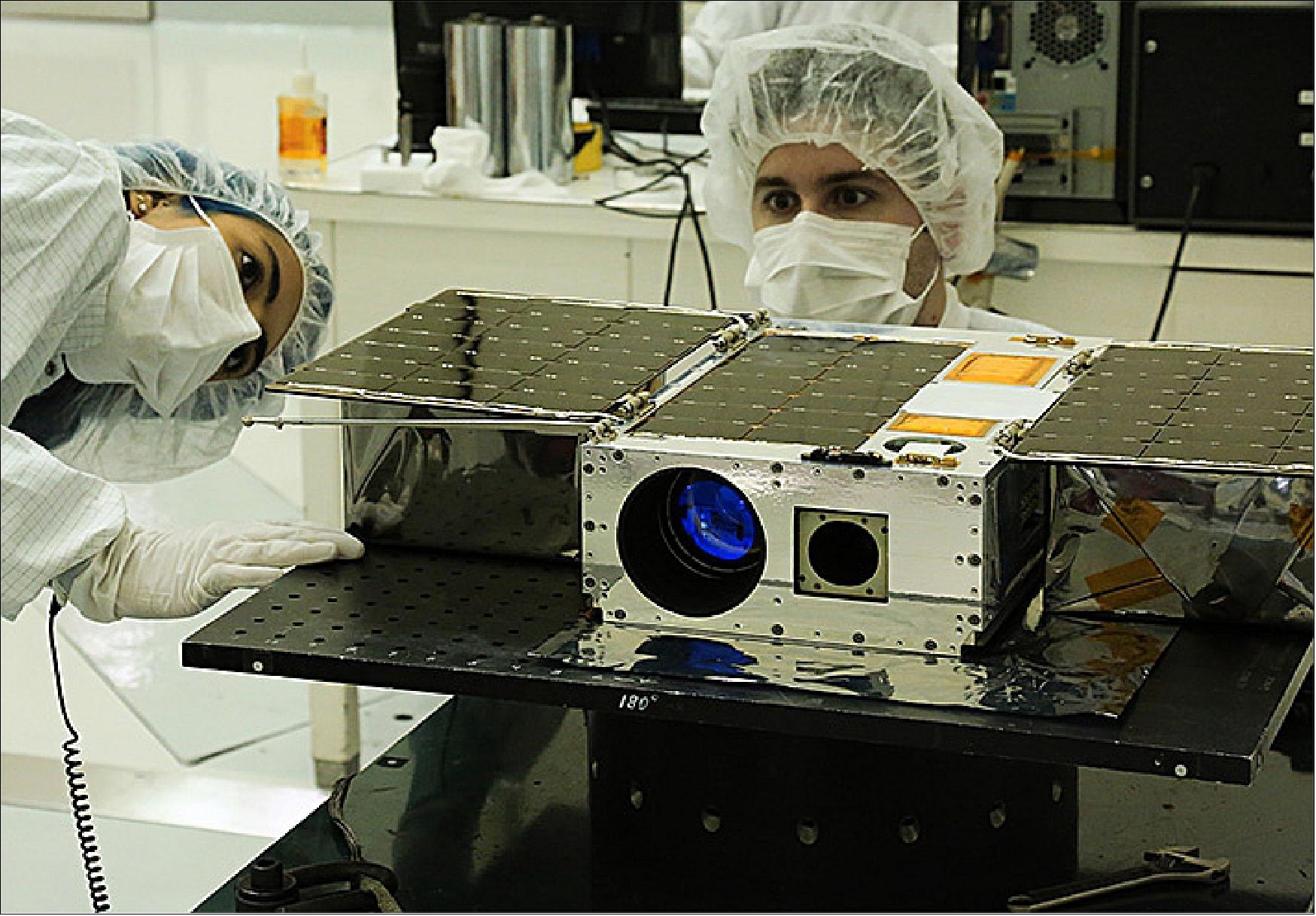

The first objective of the ASTERIA mission is to demonstrate arcsec-level pointing control both during a single observation, and from one observation to the next. The goal is to maintain the target star image to within a fraction of a detector pixel over long durations. Image motion over the detector pixels can cause variations in the measured brightness, since both the between-pixel (interpixel) and within-pixel (intrapixel) response varies across the detector. By holding the star image to the same fraction a pixel throughout an observation, the technology demonstrated by ASTERIA minimizes instrument-derived photometric variation, and enables more sensitive photometric monitoring of real astrophysical variations in the star. 4)
Pointing control is achieved through a two-stage approach. A set of reaction wheels provides coarse three-axis control of the spacecraft body, holding an inertial attitude that points the payload to a target star. Within the payload, a two-axis piezoelectric stage provides an additional level of fine control by making small, rapid adjustments to the detector position to keep the target star stationary.
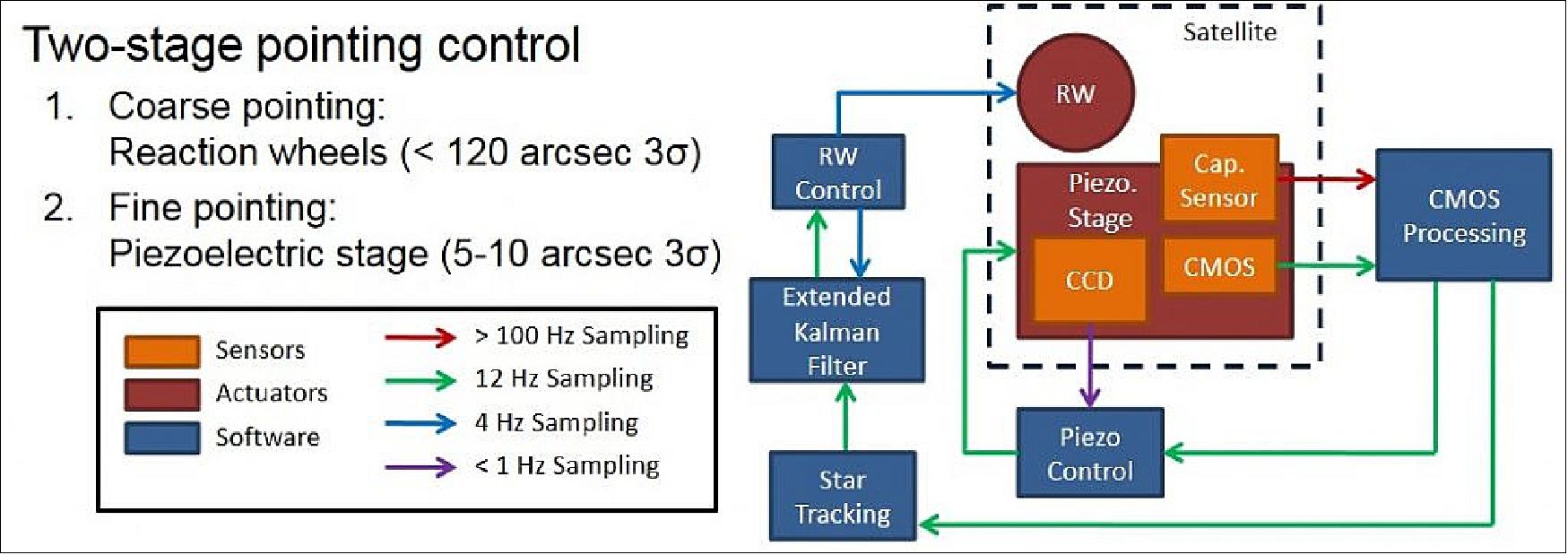
The second objective of ASTERIA is to demonstrate mK (milliKelvin)-level temperature stability of the imaging detector. The gain of each pixel is temperature sensitive, so tight thermal control reduces instrumental photometric variation that might otherwise be mistaken as an astrophysical signal. Unlike other space telescopes such as Kepler and Spitzer that reside in an Earth-trailing orbit, ASTERIA is subjected to day/night cycles that occur every 90 minutes in LEO. The lack of a stable thermal environment makes active temperature control all the more important.
Precision thermal control is achieved by isolating the payload from the spacecraft bus, and passively cooling the detector using a space-facing radiative surface. Thermal sensors and trim heaters located on the detector, act in a closed loop to perform small temperature corrections over the course of an observation, and maintain stability to the required precision.
Spacecraft mass | 10.165 kg |
Stowed dimensions | 239 mm x 116 mm x 366 mm |
Power generation | 48 W (beginning of life) |
Energy storage | 52.7 Whr (beginning of life) |
Telecom frequency | S-band |
Data rates | 32 kbit/s uplink, 1 Mbit/s downlink |
Processor | Xilinx Virtex 4FX / PowerPC405 |
Onboard storage | 14.5 GB |
The spacecraft uses a combination of commercial off-the-shelf (COTS) components, many of which are customized or modified, and components that were developed in-house.
Attitude Determination and Control: ASTERIA uses the Blue Canyon Technologies (BCT) fleXible Attitude Control Technology (XACT) unit for attitude determination and control. The XACT features a star tracker, sun sensor, inertial measurement unit (IMU), magnetometer, reaction wheels, torque rods, and processor. The XACT’s flight software is self-contained and capable of autonomously detumbling the spacecraft, searching for the sun, and maintaining a sun-pointed coarse attitude. Upon command, the XACT can slew to an inertial attitude and maintain 3-axis pointing with relatively high precision over long durations. The mission uses this capability during stellar observations.
Command and Data Handling: ASTERIA uses the CORTEX 160 flight computer from Spaceflight Industries for onboard processing and command and data handling. It uses a Virtex 4FX FPGA with an embedded PowerPC processor running Linux. JPL modified the firmware to incorporate a custom interface with the imager driver board and to add SPI interfaces that are used to interact with subsystem components.
FSW (Flight Software): The ASTERIA FSW uses F Prime, a free and open-source flight software framework developed at JPL and tailored to small-scale systems such as CubeSats, SmallSats, and instruments. 19 F Prime provides a software architecture based on components (i.e. units of FSW function similar to C++ classes) and ports (i.e. endpoints of connections from one component instance to another). Like classes, components have instances that are created when the FSW starts up.
In F Prime, FSW developers construct a high-level model that defines the components and ports, specifies the port connections, and defines the ground interface to FSW (e.g. the commands that FSW recognizes and the telemetry points that it generates). The F Prime tools auto-generate the following: (1) a partial C++ implementation of each component, to be completed by the developer, (2) C++ code for instantiating the components and connecting the ports, and (3) interface dictionaries for use by the ground data system.
The ASTERIA FSW consists of the following ten software subsystems that correspond to spacecraft functions: Attitude Control (including coarse pointing), Communication, Engineering, Fault Protection, Health Monitoring, Mode Management, Pointing Control (fine pointing), Power Management, Solar Array Deployment, and Thermal Control. It is written mostly in C++ (drivers for interacting with hardware are written in C) and contains around 201,000 lines of source code; 56% of these lines are auto-generated, and 25% are inherited. Several of the generic components developed for ASTERIA have been contributed back to the F Prime framework and others are in use by other missions at JPL. Developing the ASTERIA FSW required around six person-years of effort over 2.4 years.
Mode Manager: Much of ASTERIA’s on-orbit functionality and behavior depends on the system mode manager and the underlying fault protection design. The high-level mode diagram is shown in Figure 4. ASTERIA has two primary modes—Safe and Nominal.
Safe Mode is designed to maintain a positive energy balance across the orbital cycle (with worst-case eclipse duration) such that the spacecraft could survive for days or weeks without Earth contact. Specifically, the XACT is commanded to be in Sun Point—an internal mode that uses the sun sensor to orient the spacecraft solar panels at the Sun while in orbital daylight—and the radio is commanded into a cyclic on/off cycle that conserves energy and guarantees periodic commandability. Nominal Mode is used when executing sequences that conduct observations and perform scheduled communications passes. These operations carry somewhat higher risk than Safe Mode—for example because they rotate the spacecraft away from a Sun-pointing attitude (precluding battery charging) or operate the payload for extended periods (consuming more energy). As such, Nominal Mode activates additional layers of fault protection.
The other modes shown in Figure 4 occur in special circumstances. The spacecraft enters Initial Mode on boot, either after initial power-on following deployment form the ISS or after a flight computer power cycle. Upon deployment, Initial Mode waited for 30 minutes (as required by the ISS) before deploying the solar array and activating the other spacecraft subsystems. Following spacecraft acquisition, ground commands set onboard non-volatile flags that reconfigured Initial Mode as an immediate pass-through to Safe Mode.
Degraded Mode and Critical Mode are states governed by autonomous “load shedding” actions by the electrical power subsystem (EPS) in response to low battery voltage. The flight computer powers off in Degraded Mode and all subsystems besides the EPS power off in Critical Mode. Neither Degraded nor Critical Mode have been exercised in flight as of this writing.
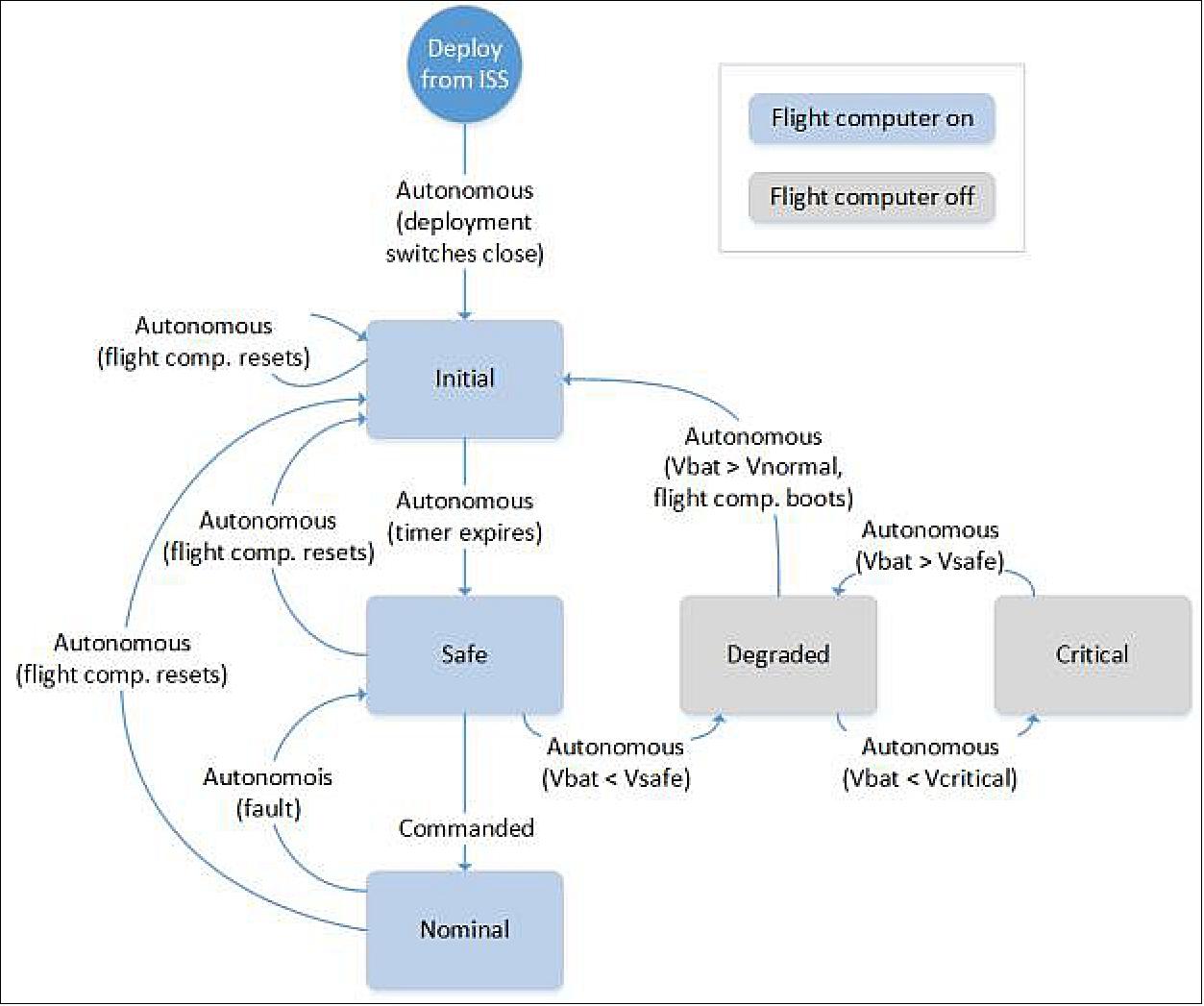
Power: The ASTERIA power subsystem consists of three main elements: the EPS (Electrical Power Subsystem) card, the battery, and the solar array. The EPS card is the GomSpace NanoPower P60, which is responsible for conditioning the solar array input, regulating the battery charge/discharge cycle, and providing power to the other subsystems. The EPS outputs the raw battery voltage along with regulated 3.3 V, 5 V, and 12 V channels. In addition to user-controlled load switching, the EPS has its own built-in fault protection. Each output switch has overcurrent protection that will power cycle the attached load if current draw exceeds a threshold (e.g. in a latchup event). The EPS also autonomously transitions between internal modes based on battery voltage. As the battery crosses user-defined voltage limits, certain subsystems are powered off to conserve the remaining charge. These cases correspond to the Degraded and Critical system modes shown in Figure 4.
The battery assembly is the GomSpace NanoPower BPX, which contains eight lithium-ion 18650 cells in series. The battery voltage varies between 24 V to 32.8 V—although voltages below approximately 29 V have never been observed in flight—and the projected end-of-life capacity is 47 Whr. Battery sizing was based on several factors, including the amount of discharge between delivery and deployment (ASTERIA used six months as a design value), expected discharge during the initial deployment and detumble period, and the required energy storage for observations during orbit eclipse.
The solar array was sourced from MMA Design LLC and consists of two deployable panels plus cells incorporated into the top panel of the spacecraft (Figure 5). The array contains eight strings, each consisting of seven SpectroLab UTJ cell-interconnect-coverglass (CIC) modules. The deployable panels are spring loaded and are held in place during launch with dedicated restraints that do not rely on the dispenser to maintain the stowed configuration.
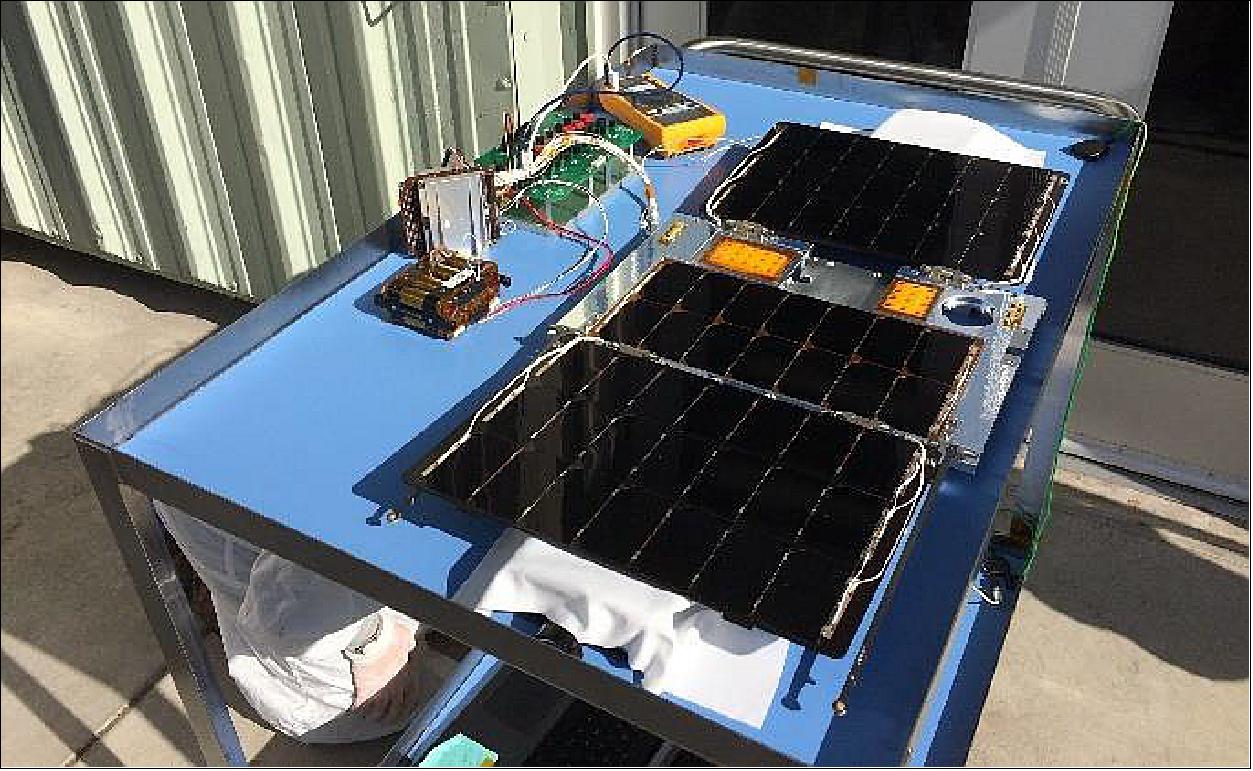
RF Communications: The ASTERIA telecommunication subsystem uses S-band for uplink and downlink. The flight element consists of a full duplex software-defined transceiver and two low-gain patch antennas on opposite surfaces of the spacecraft to enable contact while spinning. These components were manufactured by Vulcan Wireless.
The transceiver includes an internal switch to select which of the two antennas is active. It also features a diplexer to split uplink and downlink, a solid-state power amplifier, and a low-noise amplifier. The two patch antennas are identical and work at both the transmit and receive frequencies. ASTERIA uses two sets of data rates, one for Safe Mode and one for Nominal Mode. The Safe Mode data rates are 4 kbit/s uplink and 10 kbit/s downlink, and the Nominal Mode data rates are 32 kbit/s uplink and 1 Mbit/s downlink.
The ground element consists of a 21m diameter parabolic antenna at Morehead State University in Kentucky (Figure 6) and an AMERGINT softFEP-9000 modem. For cost reasons, ASTERIA does not have a backup ground station and is wholly reliant on the station at Morehead State University. To date, service availability—i.e. percentage of scheduled passes successfully executed, accounting for weather outages—has been better than 97%.
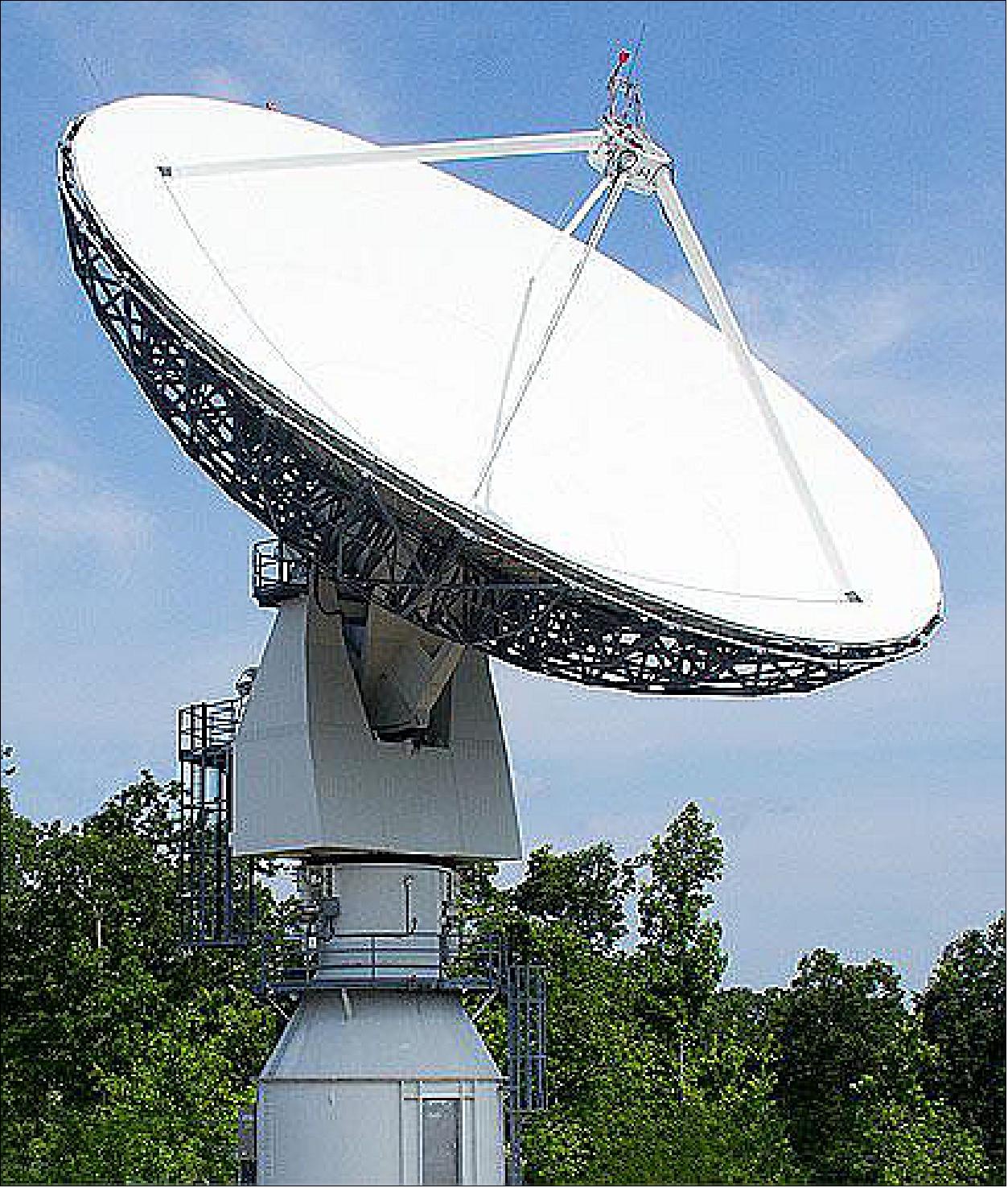
Structure: The spacecraft mechanical chassis was designed at JPL in conformance with the NanoRacks 6U deployer ICD. Instead of the four “rails” on each corner used by the traditional P-POD design, the NanoRacks specification relies on two “tabs” that run along the long edges of the spacecraft and engage with C-shaped channels in the dispenser. For ASTERIA, these two tabs were on either edge of a bottom plate to which nearly all of the internal components mounted (shown in Figure 2). By mounting components to the bottom plate, accessibility to the individual subsystems and their electrical connections during spacecraft build-up was maintained. This mounting scheme also had the advantage of allowing the components to sink heat into the spacecraft.
Spacecraft Thermal Design: To achieve the payload temperature control objective, ASTERIA required two separate but non-independent thermal designs: a design for focal plane temperature stability (described above) and the system-level thermal design. At the system level, the important inputs were the power dissipation in each operational mode and the environment. The maximum orbit-average power dissipation was 24 W, corresponding to Safe Mode operation in full sunlight. The internal dissipations and external loads (e.g. solar flux, Earth albedo) were inputs to a Thermal Desktop model that was used to evaluate surface treatments and other design decisions that maintain components at safe temperatures over the range of possible operational and environmental conditions.
A significant driver of the thermal design was the inclusion of body-mounted solar panels, which impart a non-trivial thermal load on the spacecraft when illuminated. The combination of this and other internal dissipations, and environmental loads, led to a surface coating of 10-mil silver Teflon over nearly the entire exposed surface of the spacecraft. All the chassis walls were well connected thermally, so the entire spacecraft body served as a “radiator.” The components with high power dissipation (flight computer, payload electronics, radio) were purposefully well-coupled to the bottom plate. The telescope, the batteries and the interface board were thermally isolated from the bottom plate using titanium bipods for the telescope and low conductivity polymer spacers for the batteries and interface board. The batteries were isolated in order to avoid reaching the low-temperature limit during a worst-case deployment, and the Interface Board was isolated to reduce the amplitude of the temperature disturbance on the temperature-sensing circuitry.
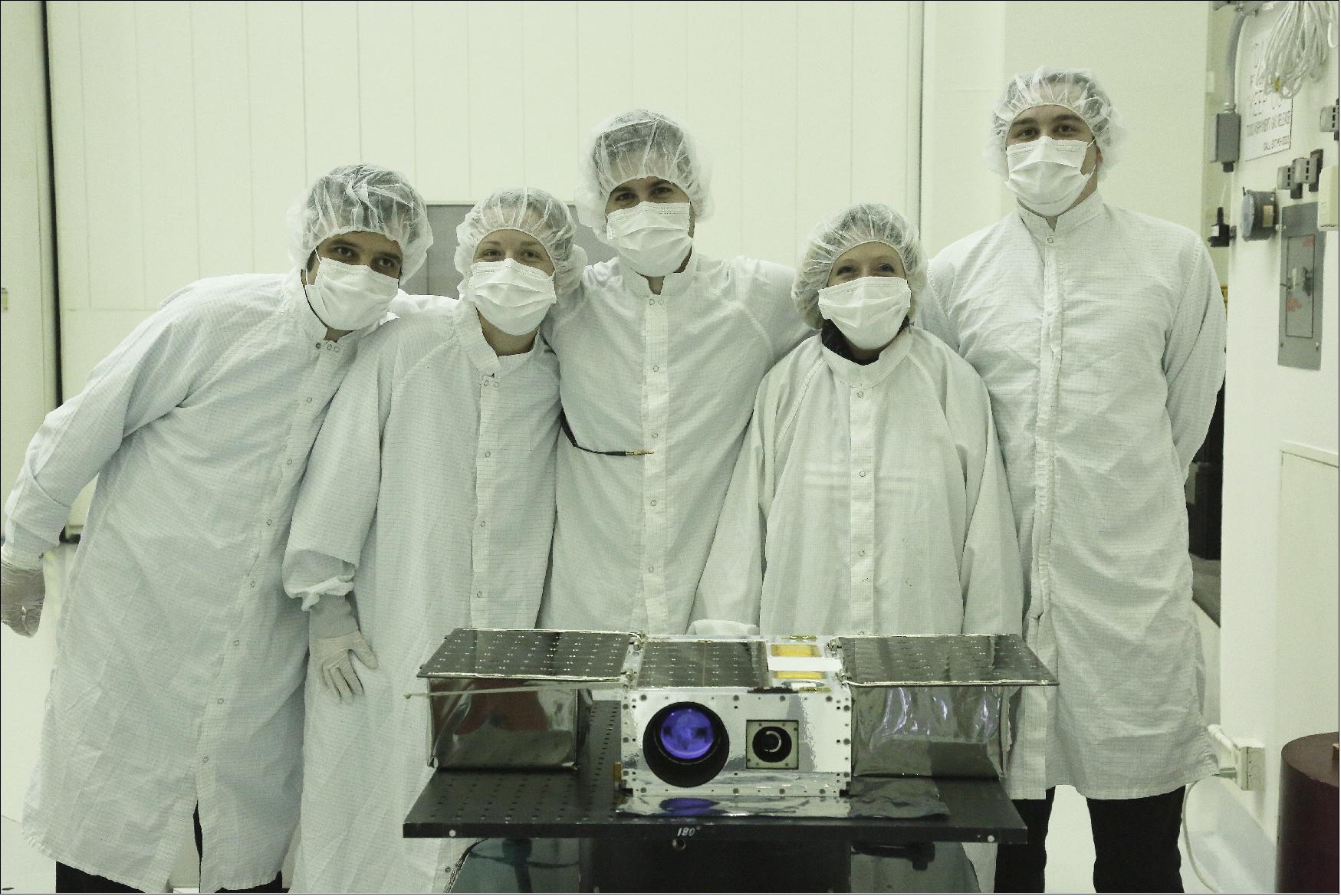
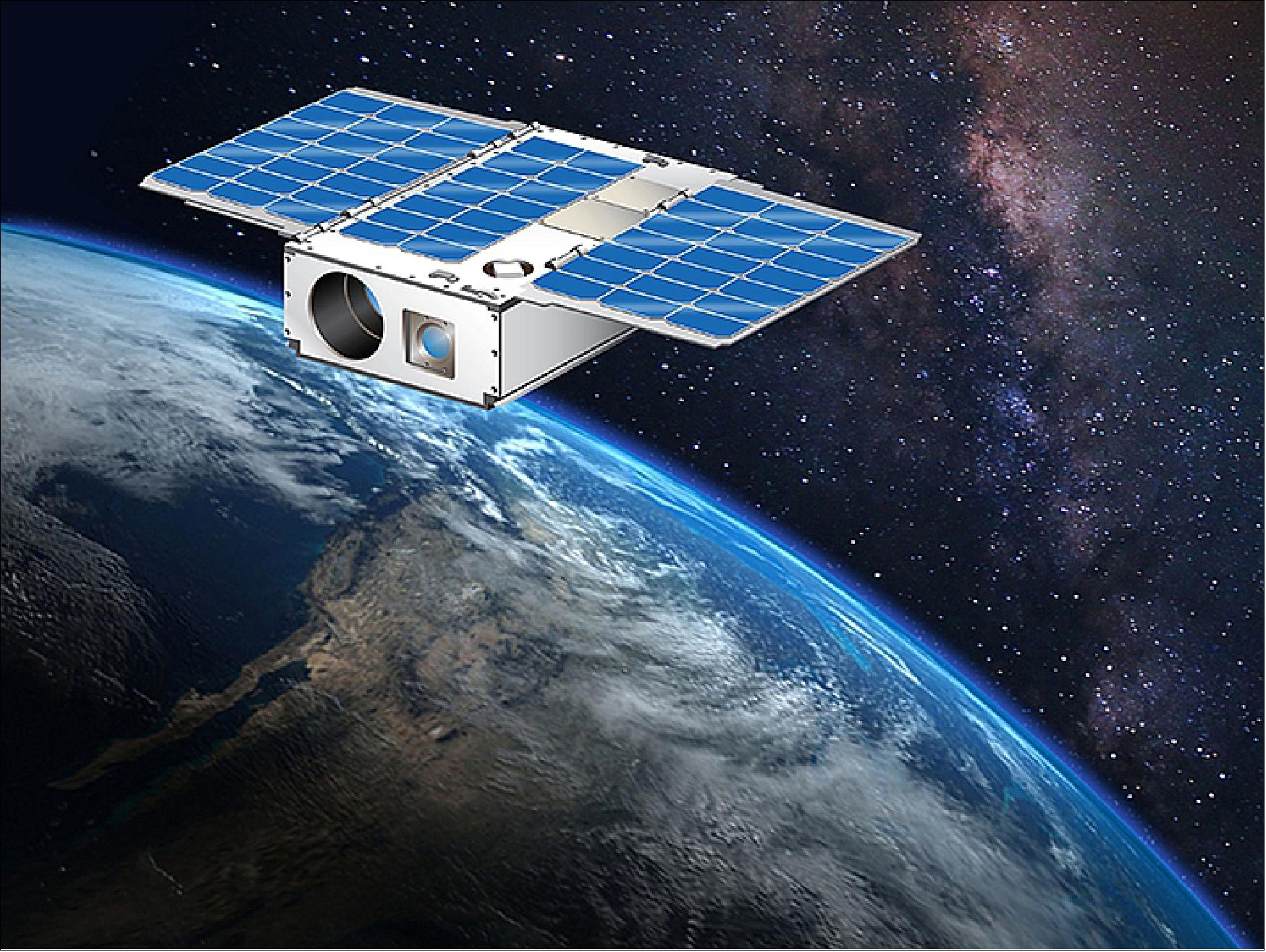
Launch
ASTERIA was launched on Aug. 14, 2017 on the SpaceX CRS-12 Dragon flight to the ISS on a Falcon-9 v1.2 vehicle. The launch site was the Launch Complex 39A (LC-39A) at NASA’s Kennedy Space Center, Florida. 5) 6)
Orbit: Near circular orbit with an altitude of~400 km, inclination = 51.6º.
Four small satellites inside the Dragon capsule were transferred to the space station for deployment later this year.
1) Kestrel Eye-2M is a pathfinder microsatellite (~50 kg) for a potential constellation of Earth-imaging spacecraft for the U.S. military.
2) ASTERIA (Arcsecond Space Telescope Enabling Research in Astrophysics), a 6U CubeSat (12 kg) of MIT and NASA/JPL. The objective is to test miniature telescope components that could be used in future small satellites to observe stars and search for exoplanets.
3) Dellingr, a NASA demonstration mission on a 6U CubeSat.
4) OSIRIS (Orbital Satellite for Investigating the Response of the Ionosphere to Stimulation and Space Weather) is a 3U Cubesat of PSU (Penn State University), University Park, PA, USA.
Mission Status
• June 2, 2020: Long before it was deployed into low-Earth orbit from the International Space Station in November 2017, the ASTERIA spacecraft had had the goal to prove that a satellite roughly the size of a briefcase could perform some of the complex tasks much larger space observatories use to study exoplanets, or planets outside the Solar System. A new paper soon to be published in the Astronomical Journal describes how ASTERIA (Arcsecond Space Telescope Enabling Research in Astrophysics) did not just demonstrate it could perform those tasks but went above and beyond, detecting the known exoplanet 55 Cancri e.
- Scorching hot and about twice the size of Earth, 55 Cancri e orbits extremely close to its Sun-like parent star. Scientists already knew the planet's location; looking for it was a way to test ASTERIA's capabilities. The small spacecraft was not initially designed to perform science; rather, as a technology demonstration, the mission's goal was to develop new capabilities for future missions. The team's technological leap was to build a small spacecraft that could conduct fine pointing control - essentially the ability to stay very steadily focused on an object for long periods.
- Based at NASA's Jet Propulsion Laboratory in Southern California and at the Massachusetts Institute of Technology, the mission team engineered new instruments and hardware, pushing past existing technological barriers to create their payload. Then they had to test their prototype in space. Though its prime mission was only 90 days, ASTERIA received three mission extensions before the team lost contact with it last December.
- The CubeSat used fine pointing control to detect 55 Cancri e via the transit method, in which scientists look for dips in the brightness of a star caused by a passing planet. When making exoplanet detections this way, a spacecraft's own movements or vibrations can produce jiggles in the data that could be misinterpreted as changes in the star's brightness. The spacecraft needs to stay steady and keep the star centered in its field of view. This allows scientists to accurately measure the star's brightness and identify the minute changes that indicate the planet has passed in front of it, blocking some of its light.
- ASTERIA follows in the footsteps of a small satellite flown by the Canadian Space Agency called MOST (Microvariability and Oscillations of Stars), which in 2011 performed the first transit detection of 55 Cancri e. MOST was about six times the volume of ASTERIA - still incredibly small for an astrophysics satellite. Equipped with a 5.9-inch (15-centimeter) telescope, MOST was also capable of collecting six times as much light as ASTERIA, which carried 2.4-inch (6-centimeter) telescope. Because 55 Cancri e blocks out only 0.04% of its host star's light, it was an especially challenging target for ASTERIA.
- "Detecting this exoplanet is exciting, because it shows how these new technologies come together in a real application," said Vanessa Bailey, the principal investigator for ASTERIA's exoplanet science team at JPL. "The fact that ASTERIA lasted more than 20 months beyond its prime mission, giving us valuable extra time to do science, highlights the great engineering that was done at JPL and MIT."
Big Feat
- The mission made what's known as a marginal detection, meaning the data from the transit would not, on its own, have convinced scientists that the planet existed. (Faint signals that look similar to a planet transit can be caused by other phenomena, so scientists have a high standard for declaring a planet detection.) But by comparing the CubeSat's data with previous observations of the planet, the team confirmed that they were indeed seeing 55 Cancri e. As a tech demo, ASTERIA also did not undergo the typical prelaunch preparations for a science mission, which meant the team had to do additional work to ensure the accuracy of their detection.
- "We went after a hard target with a small telescope that was not even optimized to make science detections - and we got it, even if just barely," said Mary Knapp, the ASTERIA project scientist at MIT's Haystack Observatory and lead author of the study. "I think this paper validates the concept that motivated the ASTERIA mission: that small spacecraft can contribute something to astrophysics and astronomy."
- While it would be impossible to pack all the capabilities of a larger exoplanet-hunting spacecraft like NASA's Transiting Exoplanet Survey Satellite (TESS) into a CubeSat, the ASTERIA team envisions these petite packages playing a supporting role for them. Small satellites, with fewer demands on their time, could be used to monitor a star for long periods in hopes of detecting an undiscovered planet. Or, after a large observatory discovers a planet transiting its star, a small satellite could watch for subsequent transits, freeing up the larger telescope to do work smaller satellites cannot.
- Astrophysicist Sara Seager, principal investigator for ASTERIA at MIT, was recently awarded a NASA Astrophysics Science SmallSat Studies grant to develop a mission concept for a follow-on to ASTERIA. The proposal describes a constellation of six satellites about twice as big as ASTERIA that would search for exoplanets similar in size to Earth around nearby Sun-like stars.
Thinking Small
- To build the smallest planet-hunting satellite in history, the ASTERIA was bit simply shrinking hardware used on larger spacecraft. In many cases, they had to take a more innovative approach. For example, the MOST satellite used a camera with a charge-coupled device (CCD) detector, which is common for space satellites; ASTERIA, on the other hand, was equipped with a complementary metal-oxide-semiconductor (CMOS) detector - a well-established technology typically used for making precision measurements of brightness in infrared light, not visible light. ASTERIA's CMOS-based, visible-light camera provided multiple advantages over a CCD. One big one: It helped keep ASTERIA small because it operated at room temperature, eliminating the need for the large cooling system that a cold-operating CCD would require.
- "This mission has mostly been about learning," said Akshata Krishnamurthy, co-investigator and science data analysis co-lead for ASTERIA at JPL. "We've discovered so many things that future small satellites will be able to do better because we demonstrated the technology and capabilities first. I think we've opened doors."
- ASTERIA was developed under JPL's Phaeton program, which provided early-career hires, under the guidance of experienced mentors, with the challenges of a flight project. ASTERIA is a collaboration with MIT in Cambridge; MIT's Sara Seager is principal investigator on the project. Brice Demory of the University of Bern also contributed to the new study. The project's extended missions were partially funded by the Heising-Simons Foundation. JPL is a division of Caltech in Pasadena, California.
• January 3, 2020: Mission operators at NASA's Jet Propulsion Laboratory in Pasadena, California, have lost contact with the ASTERIA satellite, a 6U CubeSat designed to study planets outside the Solar System. The last successful communication with ASTERIA (Arcsecond Space Telescope Enabling Research in Astrophysics), was on Dec. 5, 2019; attempts to contact it are expected to continue into March 2020. 7)
- Deployed into Earth orbit from the space station on Nov. 20, 2017, the technology demonstration mission showed that many technologies necessary for studying and potentially finding exoplanets (planets orbiting stars other than the Sun) can be shrunk to fit on small satellites. Long-term, the mission aimed to show that small satellites could one day be used to assist larger exoplanet missions, such as NASA's Transiting Exoplanet Satellite Survey (TESS).
- ASTERIA observed a handful of nearby stars and successfully demonstrated that it could achieve precision measurements of the stars' brightness. With that data, scientists look for dips in a star's light that would indicate an orbiting planet passing between the satellite and the star. (This planet-hunting technique is called the transit method.) Mission data is still being analyzed to confirm whether ASTERIA spotted any distant worlds.
- Since completing its primary mission objectives in early February 2018, ASTERIA has continued operating through three mission extensions. During that time, it has been used as an in-space platform to test various capabilities to make CubeSats more autonomous, some of which are based on artificial intelligence programs. ASTERIA also made opportunistic observations of the Earth, a comet, other spacecraft in geo-synchronous orbit and stars that might host transiting exoplanets.
- Even if contact is not regained with ASTERIA, scientists can still conduct experiments on CubeSat autonomy programs using the mission testbed - a replica of the spacecraft's internal hardware, kept on Earth for testing purposes.
- "The ASTERIA project achieved outstanding results during its three -month prime mission and its nearly two-year-long extended mission," said JPL's Lorraine Fesq, current ASTERIA program manager. "Although we are disappointed that we lost contact with the spacecraft, we are thrilled with all that we have accomplished with this impressive CubeSat."
- ASTERIA was developed under the Phaeton program at JPL. Phaeton was developed to provide early-career hires, under the guidance of experienced mentors, with the challenges of a flight project. ASTERIA is a collaboration with the Massachusetts Institute of Technology in Cambridge; MIT's Sara Seager is principal investigator on the project. The project's extended missions were partially funded by the Heising-Simons Foundation.
• May 16, 2019: ASTERIA was designed to demonstrate precision pointing technology in a CubeSat, which could be used to observe planets around other stars. After completing its primary mission objectives in January 2018, ASTERIA has continued to operate on an extended mission. The mission team took this image (Figure 9) to further test the capabilities of the satellite. 8)
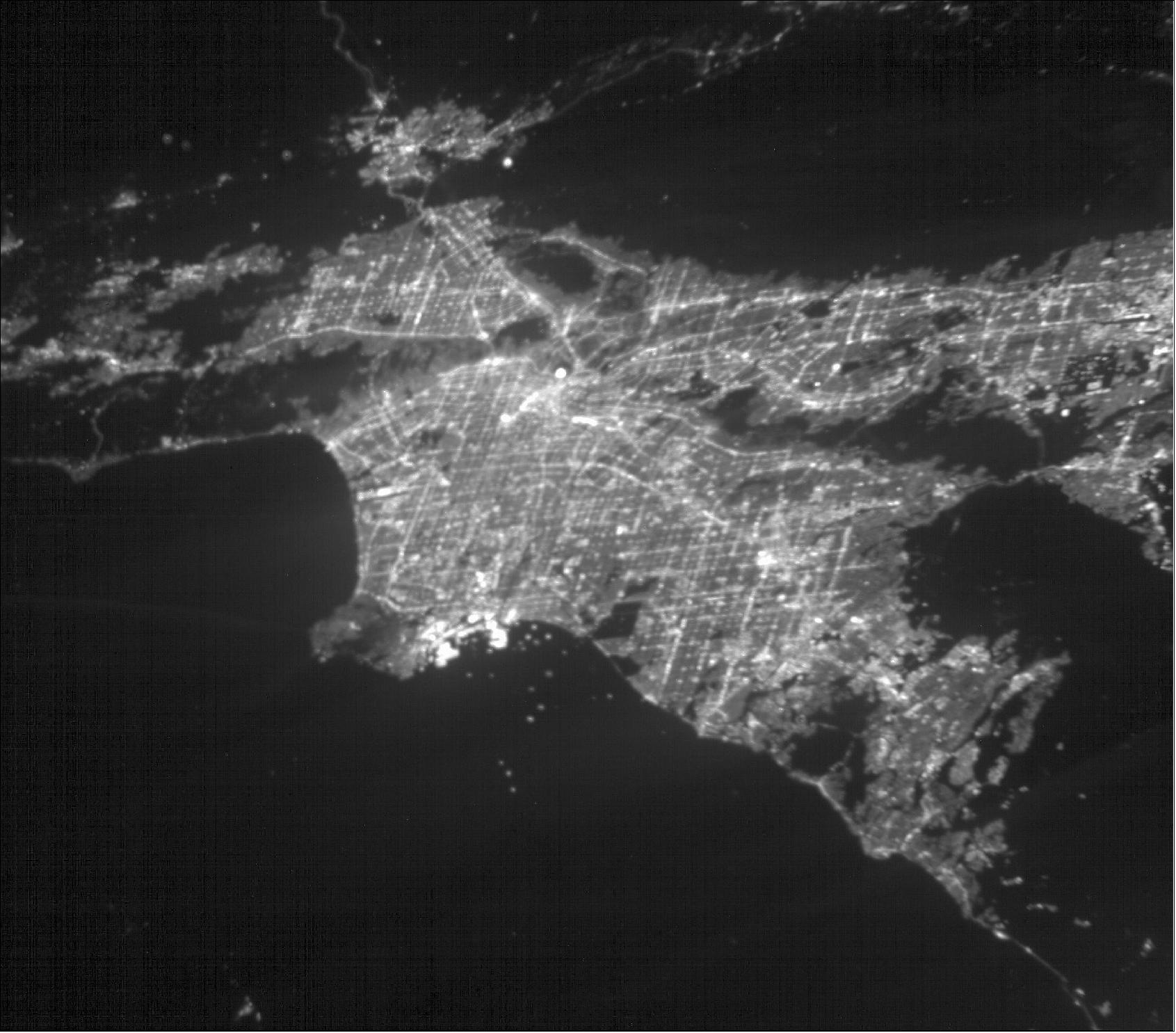
• August 14, 2018: The ASTERIA mission, a collaboration between NASA/JPL and MIT, has earned the Small Satellite Mission of the Year award from the Small Satellite Technical Committee of the American Institute of Aeronautics and Astronautics (AIAA). The award is given to a mission that has "demonstrated a significant improvement in the capability of small satellites," according to the award description. 9)
- The award was presented at this month's annual Small Satellite Conference in Logan, Utah, hosted by AIAA and Utah State University. Finalists for the award are selected by committee, and the winner is chosen through a public vote.
• August 2018: The main mission requirements are to demonstrate key technologies for enabling photometry on small satellites. The two main pointing requirements are to demonstrate 5 arcsecond RMS pointing stability over 20-minute observations and 1 arcsecond RMS pointing repeatability from observation to observation. The pointing should remain stable over an observation due to the intra-pixel gain variations and the pointing should be repeatable between observations due to the interpixel gain variations. If the light from a star hits different parts of a pixel, that can cause a change in measured flux of the star. This effect can be reduced by increasing the size of the PSF (Point Spread Function) relative to the size of a pixel, but this must be balanced against the increase in other noise sources such as read noise and dark current. Pointing error plays an important role in the overall photometric noise budget. 10)
- To put ASTERIA in context with other space missions, Figure 10 shows a plot of the RMS pointing stability (and the time period over which the stability applies) versus mass for various missions. This plot includes the Hubble Space Telescope (HST), James Webb Space Telescope (JWST), Chandra X-Ray Observatory (CXO), Solar Dynamics Observatory (SDO), Infrared Space Observatory (ISO), Planetary Transits and Oscillations of Stars (PLATO), Kepler, AKARI, Spitzer Space Telescope (SST), Wide-Field Infrared Survey Explorer (WISE), Convection Rotation and Planetary Transits (CoRoT), Transiting Exoplanet Survey Satellite (TESS), Galaxy Evolution Explorer (GALEX), Characterising Exoplanets Satellite (CHEOPS), Microvariability and Oscillations of Stars Telescope (MOST), Bright-Star Target Explorer (BRITE), Miniature X-ray Solar Spectrometer (MinXSS), and Optical Communication and Sensor Demonstration (AeroCube-OCSD-B/C).
- If a mission was left out, it was either because complete, publicly available information about the pointing capability could not be found or the author was unaware of the mission at the time of writing. The plot makes a distinction between missions that have not launched versus missions that have launched. It also denotes pointing stability numbers that are requirements versus estimated performance. As can be seen, ASTERIA has the best pointing stability performance to date for spacecraft of its size and is on par with other spacecraft that are orders of magnitude larger.
- ASTERIA is currently operating on an extended mission, which will continue as long as funding allows.
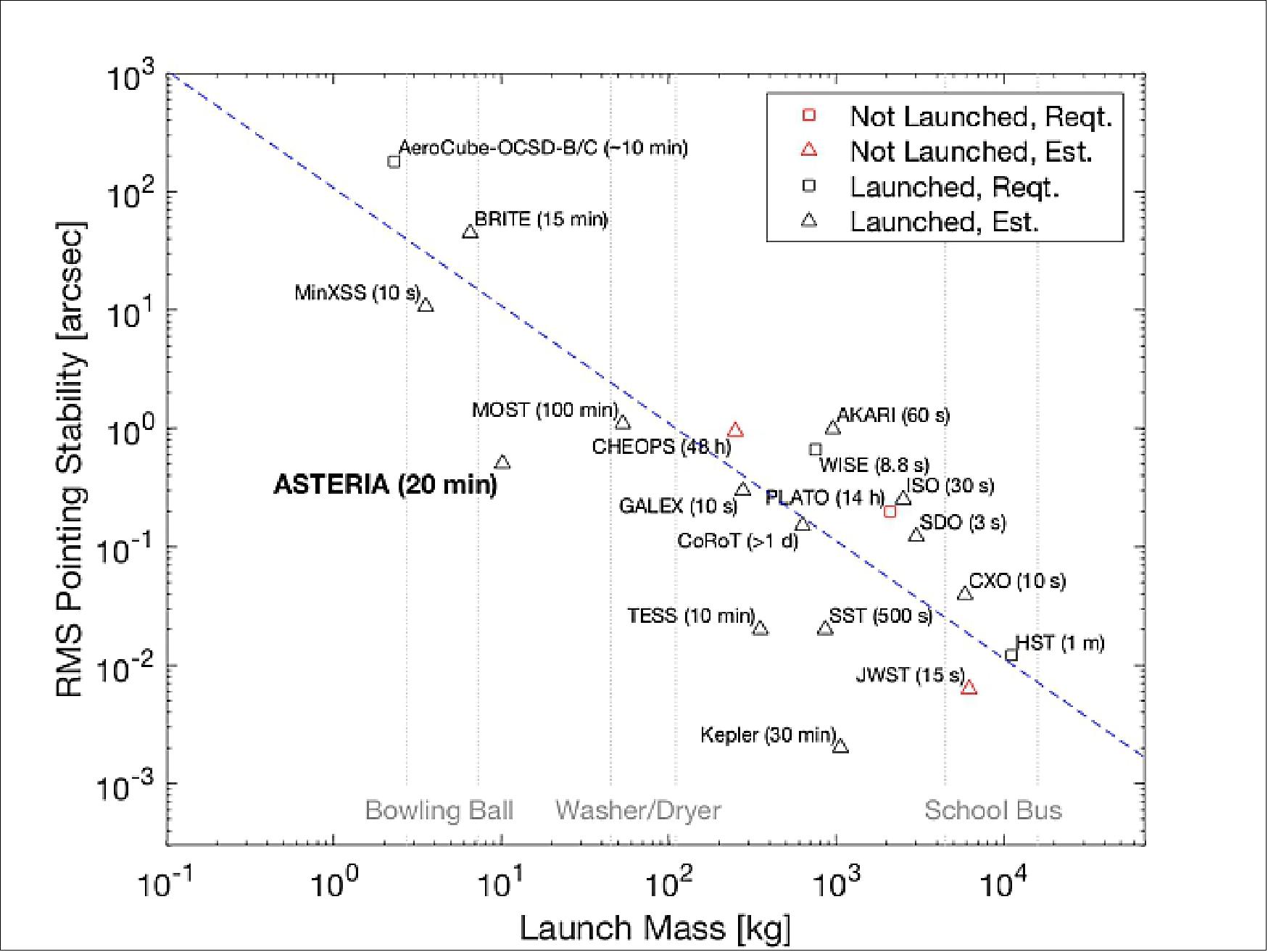
• August 2018: The goal of ASTERIA is to achieve arcsecond-level line-of-sight pointing error and highly stable focal plane temperature control. These capabilities enable precision photometry—i.e. the careful measurement of stellar brightness over time—which in turn allows investigation of astrophysical phenomena such as transiting exoplanets. — By the end of the 90-day prime mission, ASTERIA had achieved line-of-sight pointing stability of approximately 0.5 arcsec rms (root mean square) over 20-minute observations, pointing repeatability of 1 milliarcsecond rms from one observation to the next, and focal plane temperature stability better than ±0.01 K over 20-minute observations. 11)
- These achievements were enabled by a simple yet robust fault protection design, thoughtfully tailored system testing, and adaptability during flight operations. The project team—mostly early career employees—received valuable hands-on experience in flight project development and operations that they will carry into future efforts.
- Having satisfied its technology demonstration goals, ASTERIA is engaged in an extended mission to look for transiting exoplanets around nearby bright stars. Work is ongoing to improve operational efficiency by enhancing the level of MOS (Mission Operations System) automation. In the future, the technologies developed and lessons learned on ASTERIA may be applied to a fleet of small space telescopes searching for Earth-sized exoplanets. The technology is also applicable to other mission concepts in astrophysics, Earth science, space situational awareness, or any other area in which precision pointing or thermal control are important capabilities.
Orbit Geometry and Operational Impacts
Mission operations are strongly influenced by orbital geometry and the resulting patterns in eclipse timing and communication pass opportunities. ASTERIA has no propulsion and therefore resides in a similar orbit to the ISS—approximately 400 km altitude, 51.6° inclination. The orbital period is 92.6 minutes and the eclipse duration varies as a function of the beta angle (β), the angle between the orbit plane and the Earth-Sun vector. The value of β varies between 0° and 75° over the course of several weeks as the orbit slowly precesses. When β=0°, the orbit plane is coincident with the Earth-Sun vector and the eclipse duration is 35.8 minutes, its maximum value. Conversely, when β=75°, the orbit plane is nearly orthogonal to the Earth-Sun vector and the spacecraft is in daylight throughout the entire orbit (eclipse duration is zero). Figure 11 shows ASTERIA’s beta angle and eclipse duration during the prime mission.
To mitigate the effects of stray light, observations only occur during eclipse. Periods of low beta angle (long eclipse) are advantageous because they maximize viable observation time per orbit. On the other hand, these periods are more stressing on the power subsystem because the time spent in sunlight is a minimum. This relative lack of sunlight also causes reduced component temperatures that, if not properly managed, may violate allowable flight temperature (AFT) limits. Periods of high beta angle are also somewhat problematic, but for different reasons. High beta angles preclude observation (since there is no eclipse) and result in higher component temperatures due to the constant solar loading.
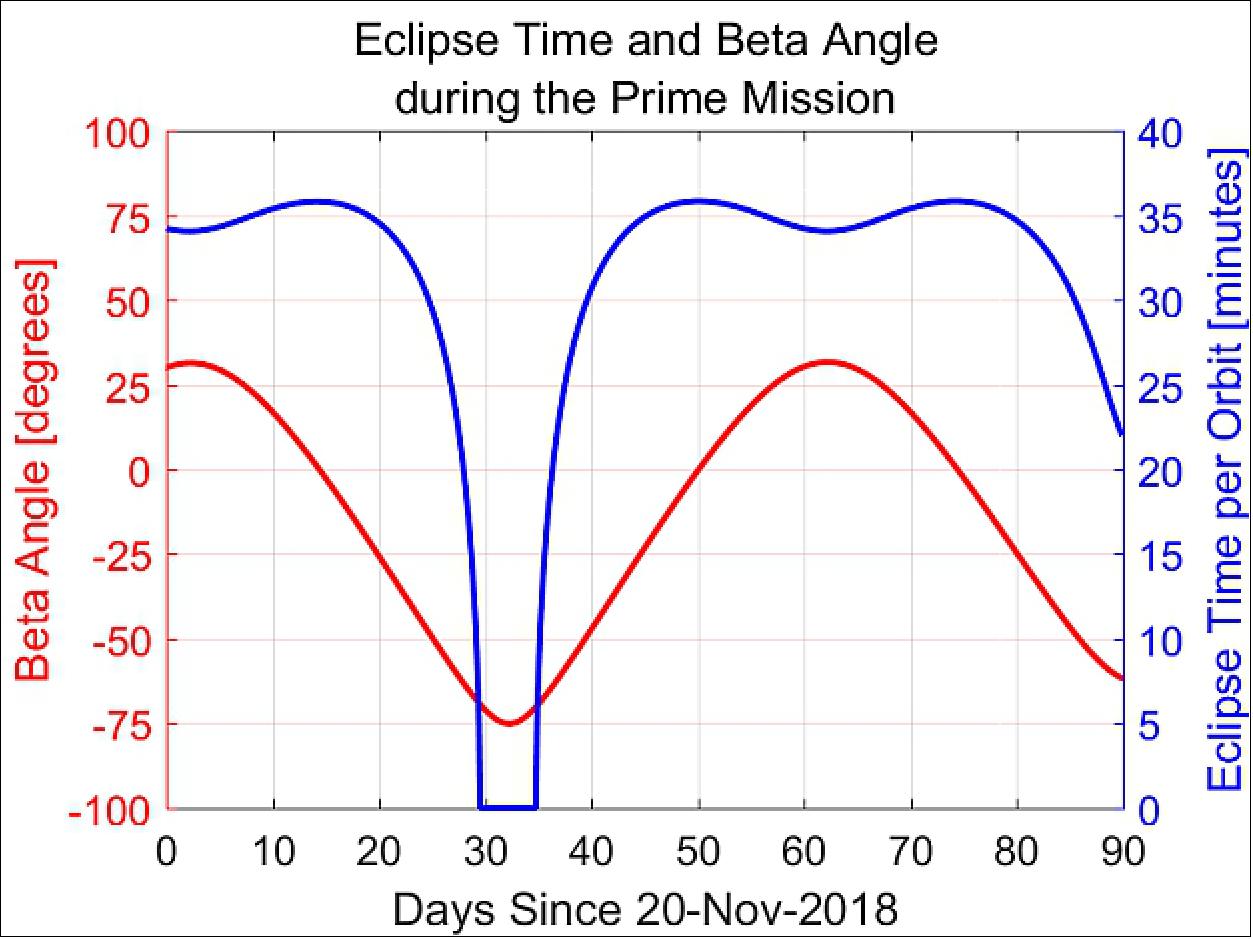
Orbit geometry also has a strong influence on communication opportunities. ASTERIA completes 15 orbits per day. Of those, six generally overfly the ground station at Morehead State University and are therefore geometrically capable of supporting communication passes (see Figure 12). Each pass lasts eight to ten minutes, and the maximum elevation as seen from the ground station varies dramatically. Of the six passes available per day, the first two are usually at higher elevation, the middle two are usually at low elevation, and the last two are at high elevation again. During routine operations, the ASTERIA ops team selects one high-elevation pair of passes per day, the choice driven by the local time of the passes at JPL and at Morehead State University.
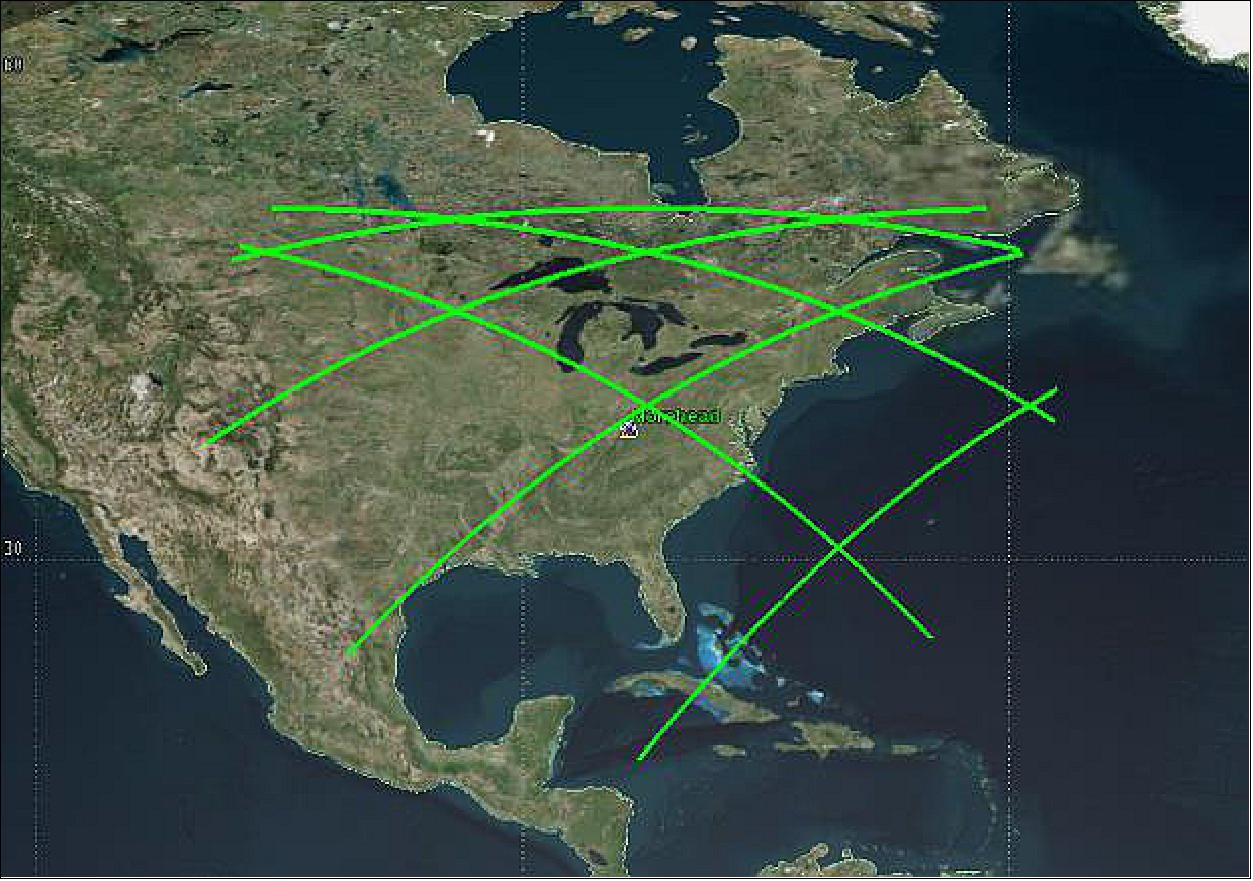
MOS (Mission Operations System)
The core of the ASTERIA mission MOS is an adapted version of the WISE Telemetry Command and Communications Subsystem (WTCCS). It is a software suite that provides capabilities for translation and transmission of commands; uplink of files; downlink of telemetry, log messages, and files; and automation of each listed capability through a TCL API. WTCCS has been augmented by a set of ASTERIA-developed Python scripts that catalog downlinked files and push the data to a server for team access. An instance of OpenMCT—a flexible, open source viewer designed for mission operations—allows team members to quickly plot and analyze spacecraft health and safety telemetry as a function of time, view GDS logs, view raw file and telemetry downlink, and create command products to downlink telemetry. Additionally, plotted telemetry may be exported as PNG (Portable Network Graphics) or JPEG (Joint Photographic Experts Group) files, and queried telemetry may be exported in CSV (Comma Separated Values), JSON (JavaScript Object Notation), or tab-delimited formats for more detailed analysis.
The ASTERIA operations team for the first few weeks of the mission consisted of seven to ten JPL staff members (depending on the activity) plus one MIT science team member co-located at JPL. As commissioning activities concluded, the team tapered down to 2.5 full-time equivalent JPL staff and one MIT science team member, where it remained for the rest of the prime mission. The ground station operators at Morehead State University consist of a half-dozen talented students who rotate through shifts.
ASTERIA operations take place in the JPL Earth Orbiting Mission Operations Center (Figure 13). During routine operation, passes generally consist of acquiring the spacecraft carrier as it rises into view of the ground station, uplinking and initiating a new sequence (e.g. to conduct an observation or schedule future passes), downlinking images and recorded engineering telemetry, and performing file maintenance (e.g. deleting previously downlinked data). The operations team uses TLE (Two-Line Element) sets from the JSpOC (Joint Space Operations Command) for orbit prediction and pass planning.
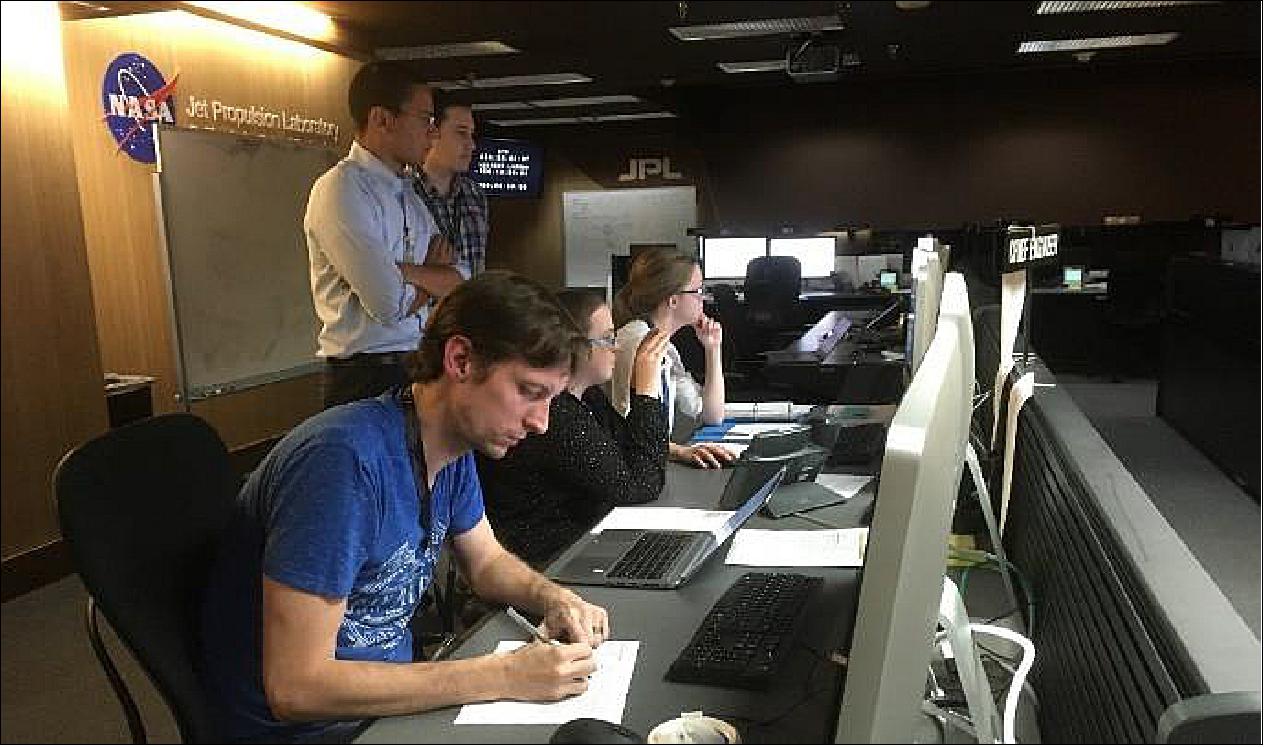
Deployment, Acquisition, and Commissioning
Unlike most CubeSats deployed from the ISS, ASTERIA—and the other CubeSats in the airlock cycle—deployed into space individually and with a 3-hour plus gap between each deployment. Thus, the tracking ambiguities often associated with simultaneous ISS deployments were avoided. ASTERIA’s TLE was available within 12 hours of deployment.
The first attempt at contact occurred on 22 November 2017 at 00:39 UTC (approximately 36 hours after deployment). This attempt was unsuccessful because—as later determined via recorded telemetry—the radio on/off cycle in Safe Mode was, coincidentally, in the off state during the first pass. Approximately 90 minutes later, during the second pass of the mission, the operations team made initial contact with ASTERIA and received on-orbit telemetry for the first time via the Morehead State University ground station.
Data downlinked in the mission’s opening days confirmed that the deployment logic had executed as desired, including the required 30-minute powered-off period immediately after ejection from the ISS, followed by solar array deployment, detumble, and sun acquisition. The initial tip-off rates were less than 1 degree per second in all three axes. The low initial rates combined with ASTERIA’s deployment into orbital daylight allowed the XACT to find, acquire, and settle in a Sun-pointed attitude within 150 seconds.
The first week of the mission was dedicated to checking out the spacecraft subsystems and evaluating the on-orbit performance against pre-launch predictions. Results for the power subsystem are shown in Figure 14 and Figure 15. The on-orbit maximum battery voltage was very close to the predicted value (within 0.13 V). The on-orbit measured solar array power was approximately 5 W greater than the predicted value, excluding periods of transition into or out of eclipse.
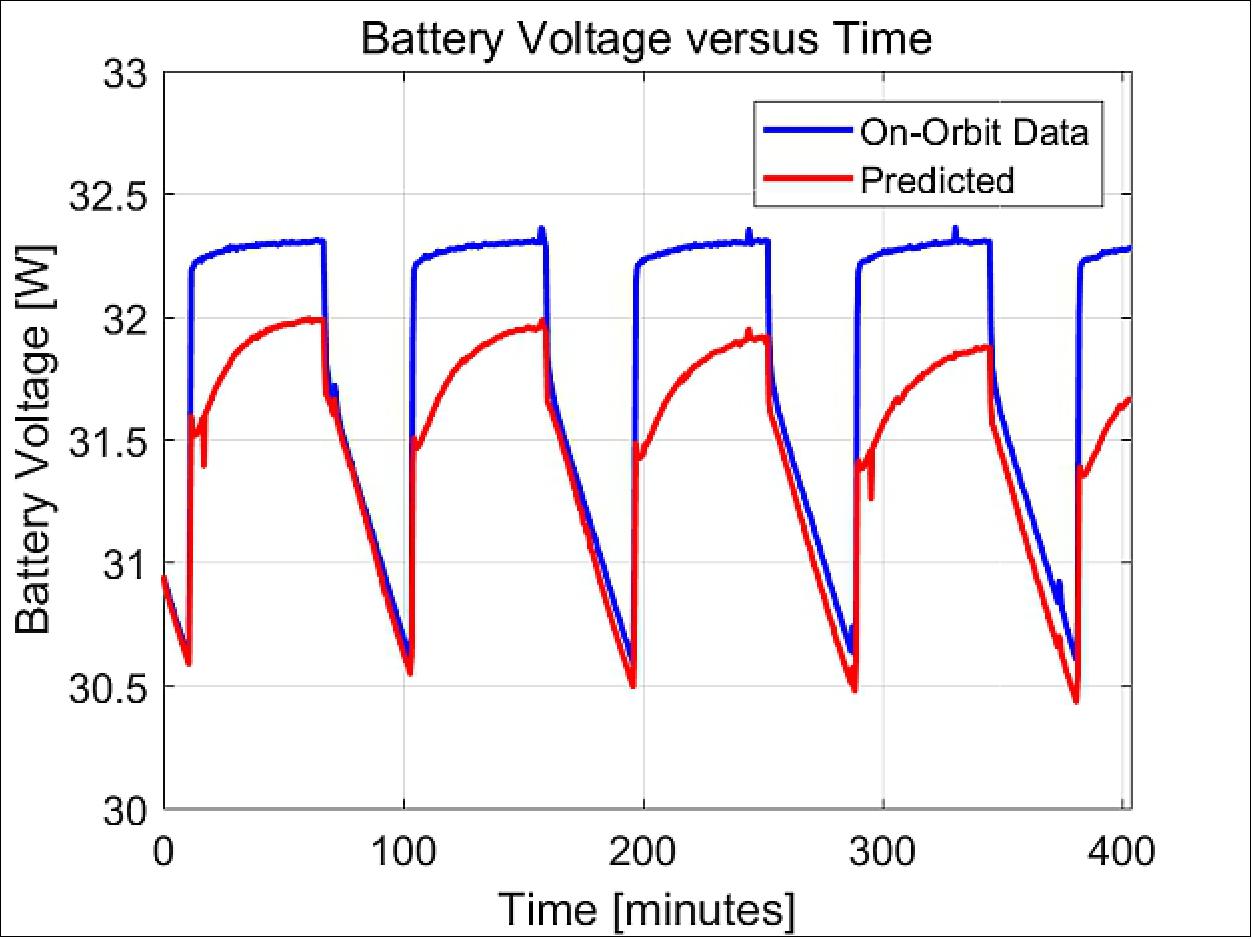
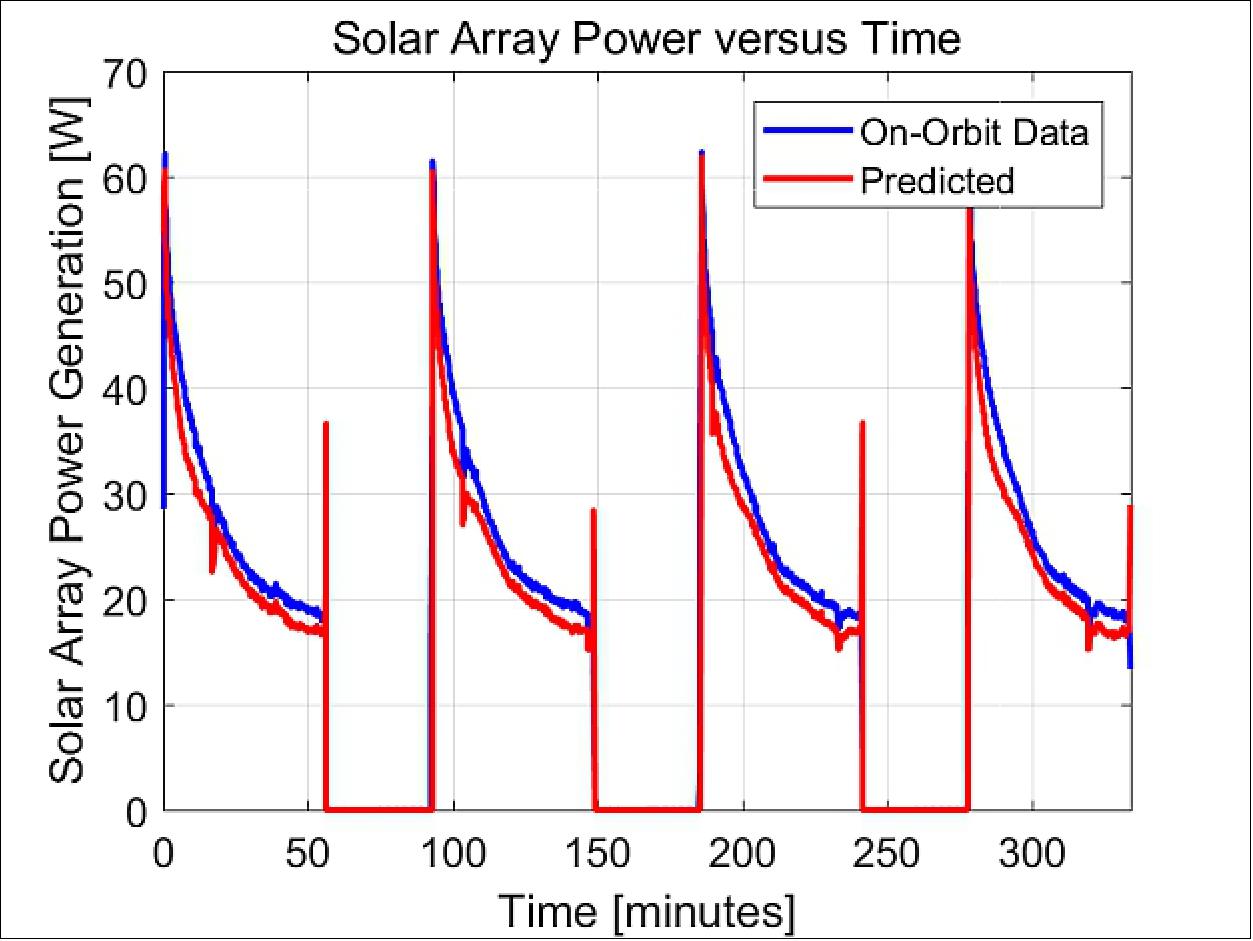
For further information, the reader is referred to Ref. 11).
• April 12, 2018: The ASTERIA satellite, which was deployed into low-Earth orbit on 21 November 2017, is only slightly larger than a box of cereal, but it could be used to help astrophysicists study planets orbiting other stars. Mission managers at NASA's Jet Propulsion Laboratory in Pasadena, California, recently announced that ASTERIA has accomplished all of its primary mission objectives, demonstrating that the miniaturized technologies on board can operate in space as expected. This marks the success of one of the world's first astrophysics CubeSat missions, and shows that small, low-cost satellites could be used to assist in future studies of the universe beyond the solar system. 12)
- "ASTERIA is small but mighty," said Mission Manager Matthew W. Smith of JPL. "Packing the capabilities of a much larger spacecraft into a small footprint was a challenge, but in the end we demonstrated cutting-edge performance for a system this size."
- ASTERIA (Arcsecond Space Telescope Enabling Research in Astrophysics) with a mass of 10 kg allows researchers to monitor nearby stars for orbiting exoplanets that cause a brief drop in brightness as they block the starlight.
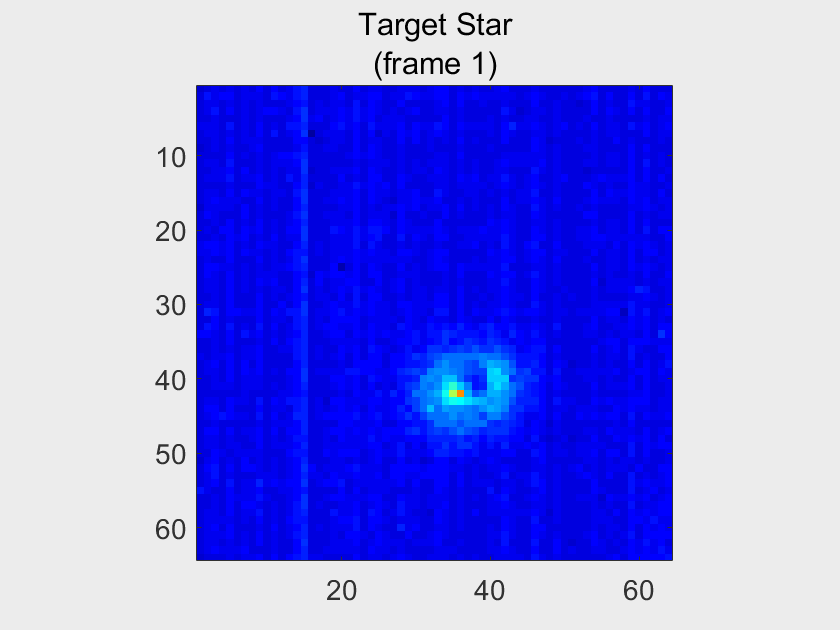
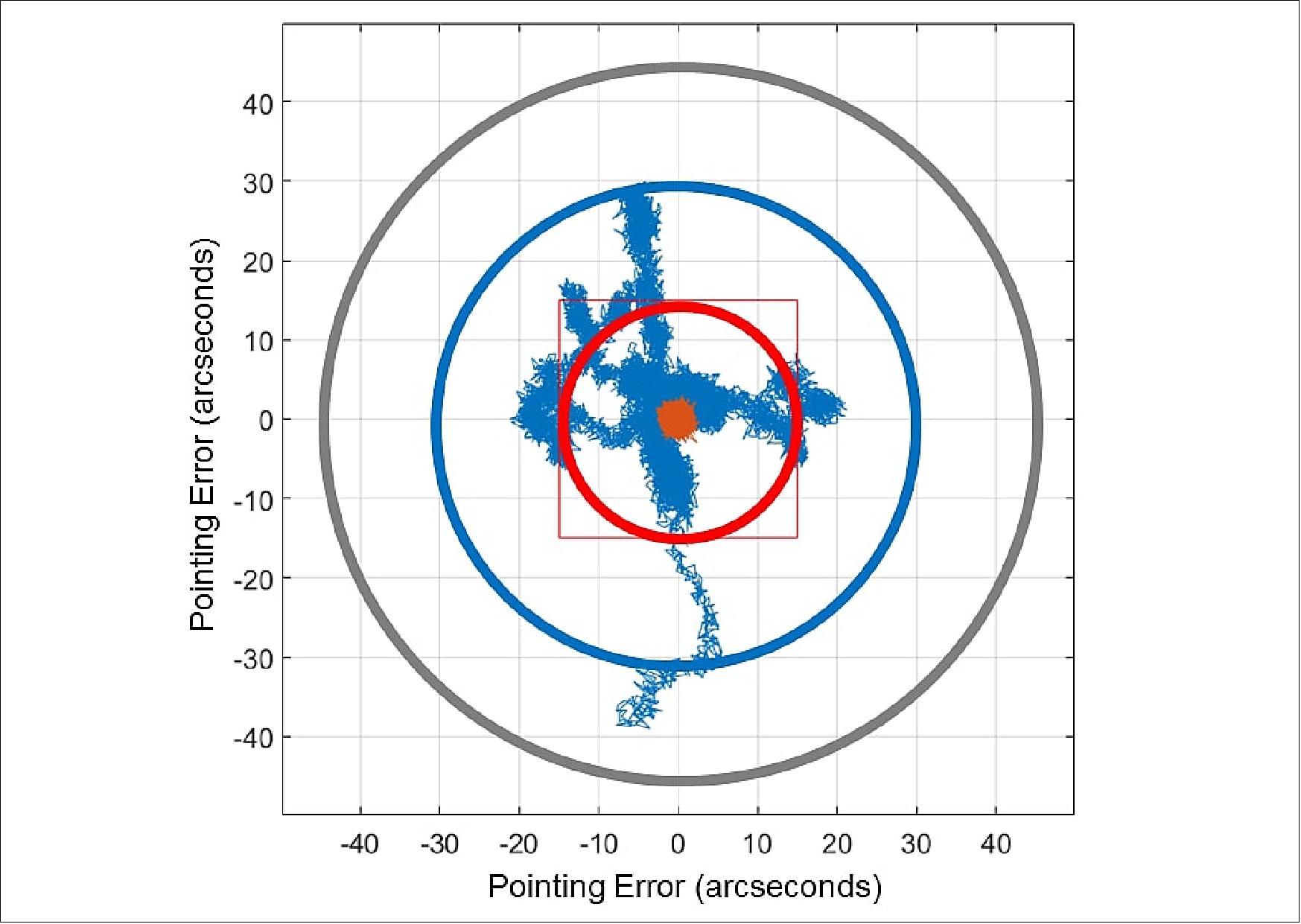
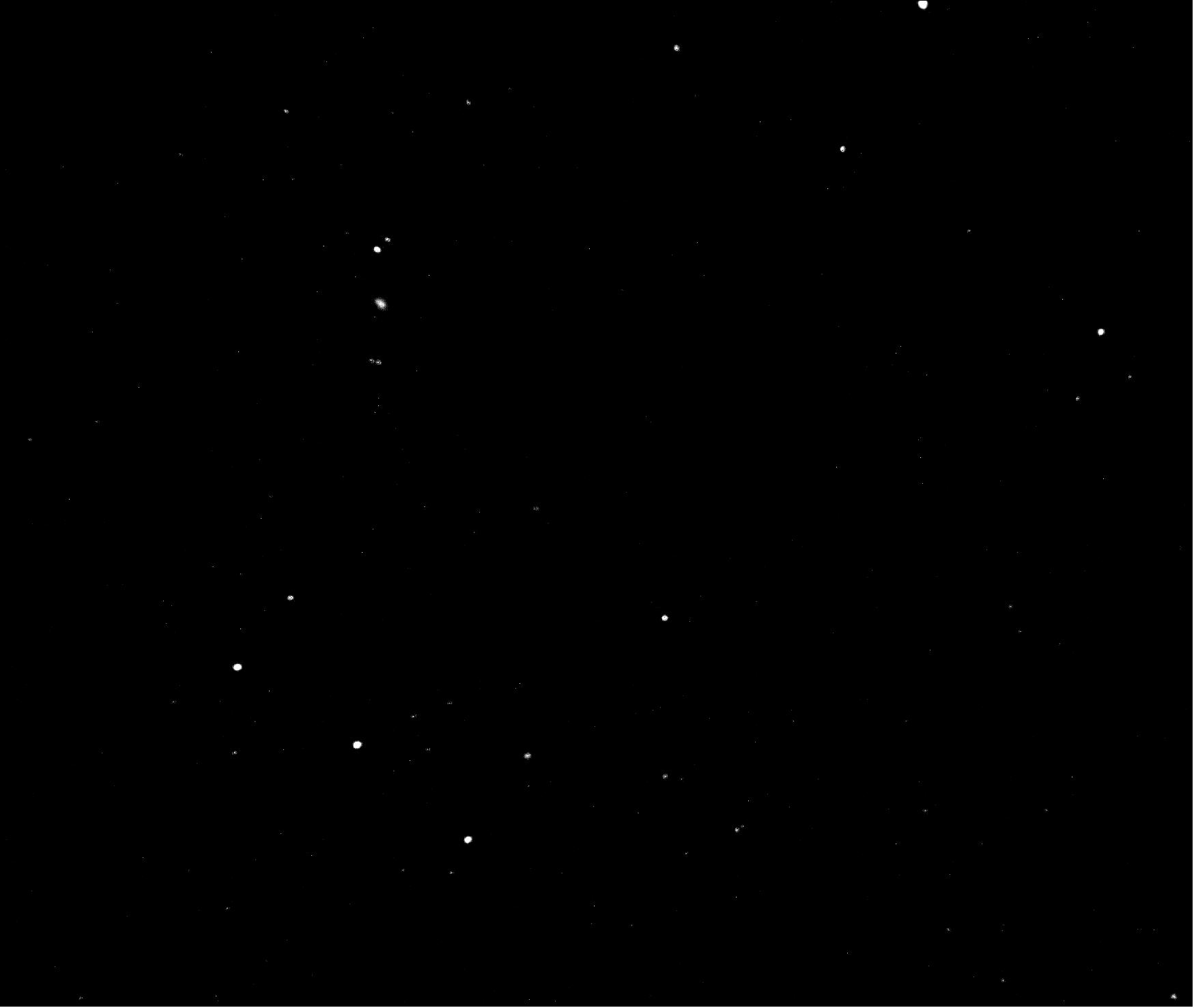
- This approach to finding and studying exoplanets is called the transit method. NASA's Kepler Space Telescope has detected more than 2,300 confirmed planets using this method, more than any other planet-hunting observatory. The agency's next large-scale, space-based planet-hunting observatory, the Transiting Exoplanet Survey Satellite (TESS), is anticipated to discover thousands of exoplanets and scheduled to launch from Cape Canaveral Air Force Station in Florida on April 16.
- In the future, small satellites like ASTERIA could serve as a low-cost method to identify transiting exoplanets orbiting bright, Sun-like stars. These small satellites could be used to look for planetary transits when larger observatories are not available, and planets of interest could then be studied in more detail by other telescopes. Small satellites like ASTERIA could also be used to study certain star systems that are not within the field of view of larger observatories, and most significantly, focus on star systems that have planets with long orbits that require long observation campaigns.
- The ASTERIA team has now demonstrated that the satellite's payload can point directly and steadily at a bright source for an extended period of time, a key requirement for performing the precision photometry necessary to study exoplanets via the transit method.
- Holding steady on a faraway star is difficult because there are many things that subtly push and pull on the satellite, such as Earth's atmosphere and magnetic field. ASTERIA's payload achieved a pointing stability of 0.5 arcseconds RMS, which refers to the degree to which the payload wobbles away from its intended target over a 20-minute observation period. The pointing stability was repeated over multiple orbits, with the stars positioned on the same pixels on each orbit.
- "That's like being able to hit a quarter with a laser pointer from about a mile away," said Christopher Pong, the attitude and pointing control engineer for ASTERIA at JPL. "The laser beam has to stay inside the edge of the quarter, and then the satellite has to be able to hit that exact same quarter — or star — over multiple orbits around the Earth. So what we've accomplished is both stability and repeatability."
- The payload also employed a control system to reduce "noise" in the data created by temperature fluctuations in the satellite, another major hurdle for an instrument attempting to carefully monitor stellar brightness. During observations, the temperature of the controlled section of the detector fluctuates by less than 0.02 Fahrenheit (0.01 Kelvin, or 0.01 degree Celsius).
- The 6U CubeSat, with a size of 10 x 20 x 30 cm, is about as long as a skateboard when its solar panels are deployed. COTS (Commercial-Off-The-Shelf) hardware is used whenever possible. "We're continuing to characterize CubeSat components that other missions are using or want to use," said Amanda Donner, mission assurance manager for ASTERIA at JPL.
• The ASTERIA 6U CubeSat was deployed from the International Space Station on November 21, 2017. It will test the use of CubeSats for astronomy research. 13)
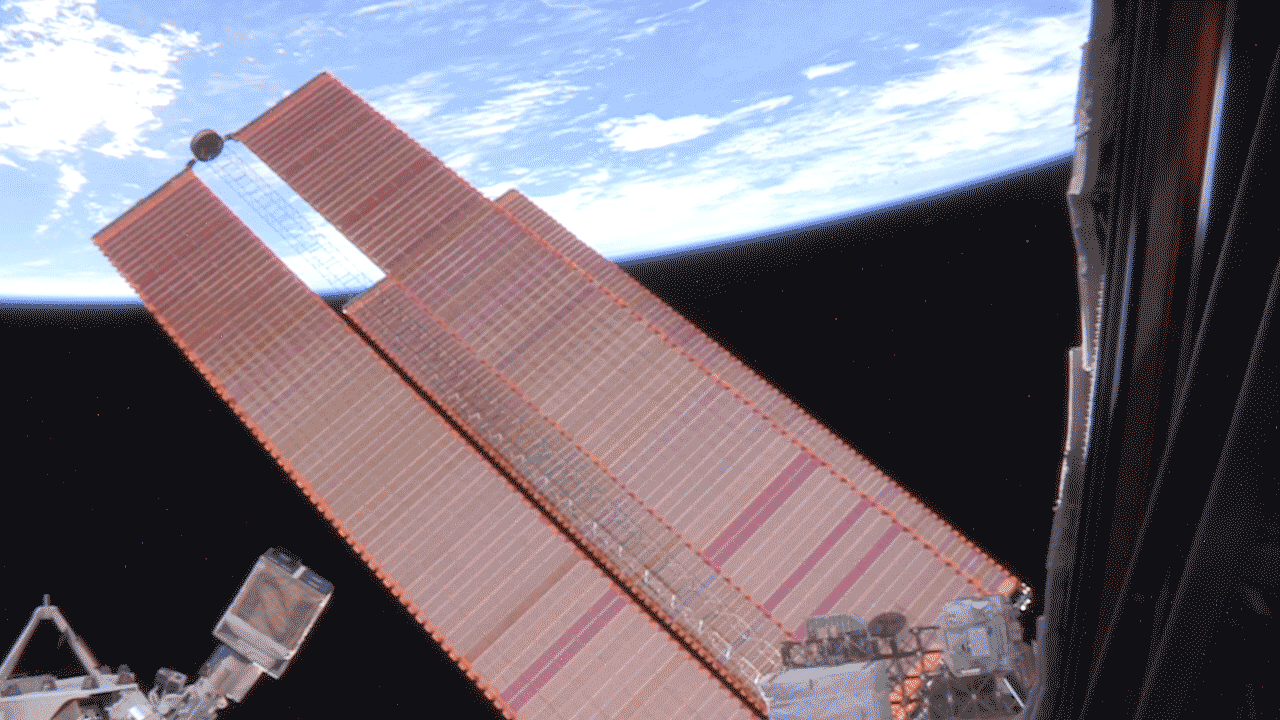
- For the next few months, the ASTERIA technology demonstration will test whether a CubeSat can perform precise measurements of change in a star's light. This fluctuation is useful for a number of commercial and astrophysics applications, including the discovery and study of planets outside of the Solar System, known as exoplanets.
NanoRacks statement of the deployment of 5 CubeSats on 21 Nov. 201714)
• November 21, 2017: NanoRacks successfully completed the Company’s 13th CubeSat deployment mission from the International Space Station. As these five CubeSats enter low-Earth orbit, this brings NanoRacks to 176 total CubeSats deployed into space via the NRCSD (NanoRacks CubeSat Deployer).
Additionally, NanoRacks shared that this mission marked the first deployment of the industry standard 6U CubeSats in the 2U x 3U form factor from the NanoRacks ‘Doublewide’ Deployers. The 6U satellites deployed were EcAMSat, Dellingr, and ASTERIA.
The NRCSD-13 Mission included satellites launched on the most recent SpaceX and Orbital ATK commercial resupply services missions to station for NASA, which launched Aug. 14 and on Nov. 12, 2017, respectively.
The CubeSats deployed on this mission were:
- ASTERIA, a 6U CubeSat of NASA/JPL and MIT.
- ECAMsat, a 6U CubeSat developed by the NASA/ARC, in partnership with Stanford University School of Medicine.
- Dellingr, a 6U CubeSat developed by NASA/GSFC.
- TechEdSat-6, a 4U CubeSat developed by San Jose State University and the University of Idaho as a collaborative engineering project with oversight from NASA Ames.
- OSIRIS, a 3U CubeSat developed by Pennsylvania State University.
Sensor Complement
Imager
ASTERIA relies on precision photometry, a field that measures the flux, or intensity, of an object's light. To be useful to any scientist, a space telescope has to correct for internal sources of error while making these measurements.
The sensor suite includes an optics section, a dual-imager focal plane array realizing the two payload functions and a piezoelectric nano-positioning stage capable of moving the focal plane to zero-out the platform jitter.
Per the ExoPlanetSat baseline, the optics section was to use a f1.4/85 Zeiss lens with a 28.6º FOV (Field of View) and six elements, focusing an image 43 mm in diameter onto the focal plane. The focal plane array houses two active detector areas – one larger CMOS detector that fulfills the science function and a smaller CMOS sensor with smaller pixel sizes to act as a rapid-cadence star camera to provide attitude knowledge to the attitude control system. The science sensor operates at longer integration times and collects data on several pixel windows, one for the target star and several other bright stars for comparison plus dark areas of the sky for dark current correction.
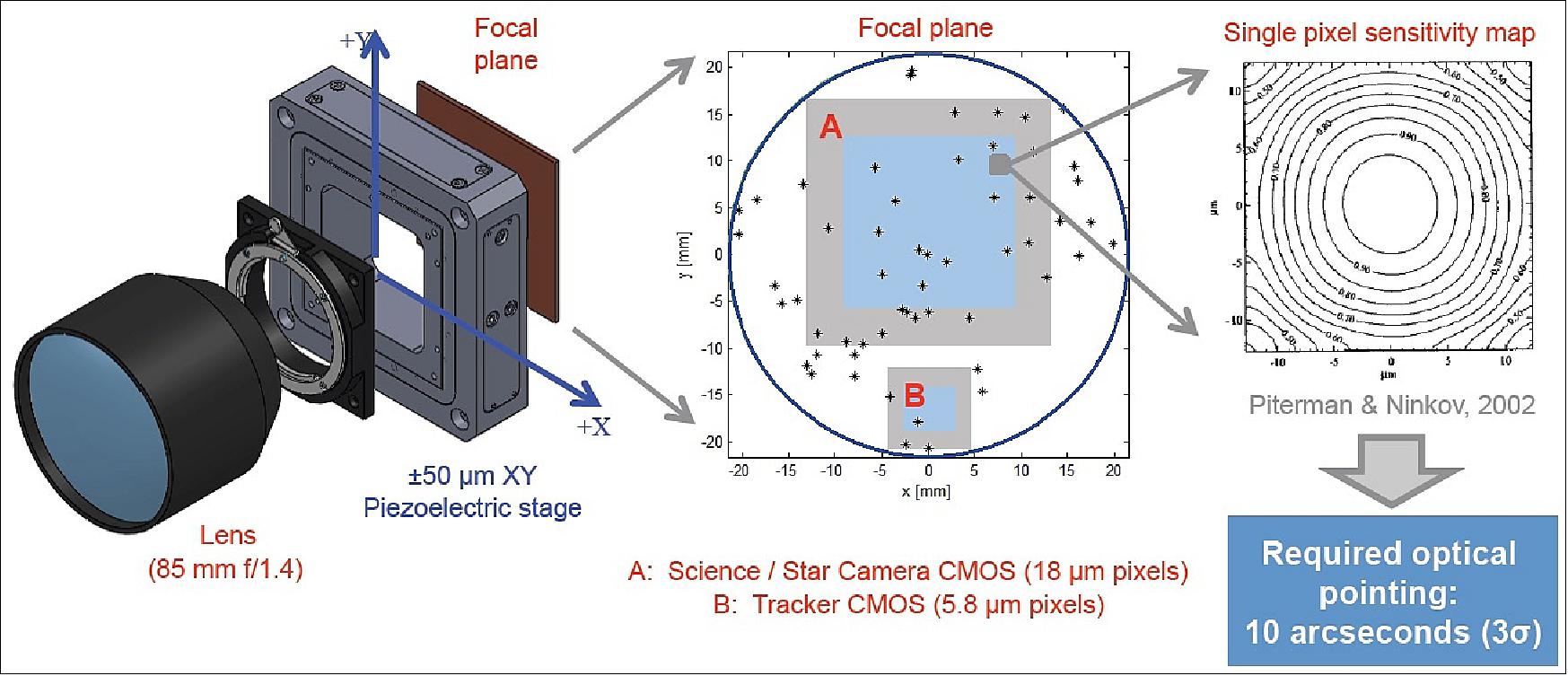
The ASTERIA payload is a compact, wide field-of-view optical telescope that contains specialized hardware to perform the pointing and thermal control functions outlined above. It consists of two major subassemblies: the OTA (Optical Telescope Assembly and the PEA (Payload Electronics Assembly).
The OTA consists of a lens assembly, a two-axis piezoelectric nanopositioning stage, an imager, a thermal strap, and a baffle (Figure 21). The lens assembly is a custom 5-element refractive design that is similar to a single lens reflex (SLR) camera lens but with additional features to withstand the environments of launch and low-Earth orbit (LEO). The first optic has coatings that restrict the pass band to wavelengths from 500 nm to 900 nm. The optical design, optomechanical design, assembly, and alignment were performed at JPL. The imager is a Fairchild CIS2521 frontside illuminated CMOS sensor containing 2592 by 2192 pixels, each 6.5 µm square. The imager mounts to the moving portion of the piezo stage, and the stationary portion of the piezo stage mounts to the lens assembly. This arrangement allows the imager to translate ±50 µm in the two axes orthogonal to the optical axis. The ability to translate the imager within the focal plane is optically equivalent to tip/tilt control and is used for fine pointing correction. The piezo stage is manufactured by Physik Instrumente and is a modified version of the off-the-shelf P-733.2CD model that has been customized to withstand launch and the vacuum of space.
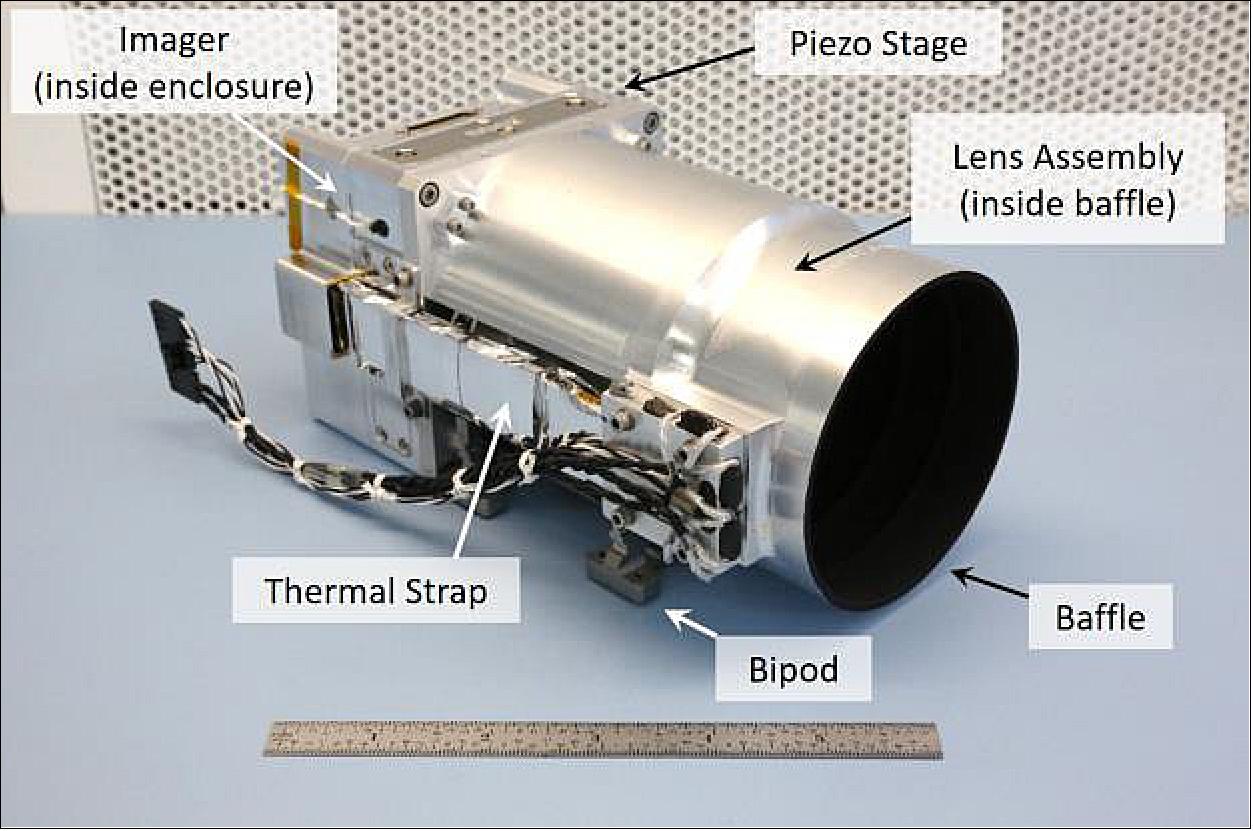
A baffle surrounds the lens assembly and blocks stray light from the Moon and the Earth limb. A thermal strap connects the back of the imager with the baffle, providing a thermal path for rejecting heat dissipated by the imager. The thermal strap has a pyrolytic graphite film construction for the flexible section and aluminum terminals on each end. It was manufactured by Thermotive LLC.
The PEA contains the electronics required to operate the payload: the imager driver board, the flight computer, and the piezo driver board. The imager driver board was designed and manufactured by Ecliptic Enterprises and its firmware was implemented at JPL. The imager driver board is responsible for powering, configuring, and reading pixel data from the imager. It shares a custom FPGA-level interface with the flight computer that allows the transfer of image data for processing by the pointing control algorithm and storage in nonvolatile memory for later downlink.
The piezo driver board was designed at JPL and contains the electronics to create the piezo drive voltages from the raw battery bus, command the stage position, read the stage position, operate the piezo stage in closed loop using strain gauge feedback, and implement a notch filter to avoid exiting resonant frequencies in the stage.
The payload has two modes of operation: full frame and windowed. In full frame mode, the payload acquires a single image containing all pixels in the array. This captures a wide view of the sky (11.2° by 9.6°) and is used for calibration purposes. In windowed mode—the mode used for observations—up to eight windows, each with 64 x 64 pixels, are read at 20 Hz (yielding approximately 50 milliseconds of integration time). Depending on the star field, all or a subset of those windows are used by the pointing control algorithm. For photometric observations, windows from 1200 consecutive integrations are co-added onboard to form integrations covering 60 seconds.
Pointing Control Approach: ASTERIA implements a “two-stage” approach to pointing control, shown conceptually in Figure 22. During observations, the XACT points the optical boresight at the target star and maintains “coarse” attitude control for 20 minutes or more (the observation duration depends on the available orbital eclipse). In a 20 Hz control loop, windowed star images are read out of the detector and processed by a centroiding algorithm. Deviations between the measured and desired centroid locations are fed into a control algorithm that translates the piezo stage to compensate for the pointing error. The result is that the target star image remains relatively stationary with respect to the pixel boundaries.
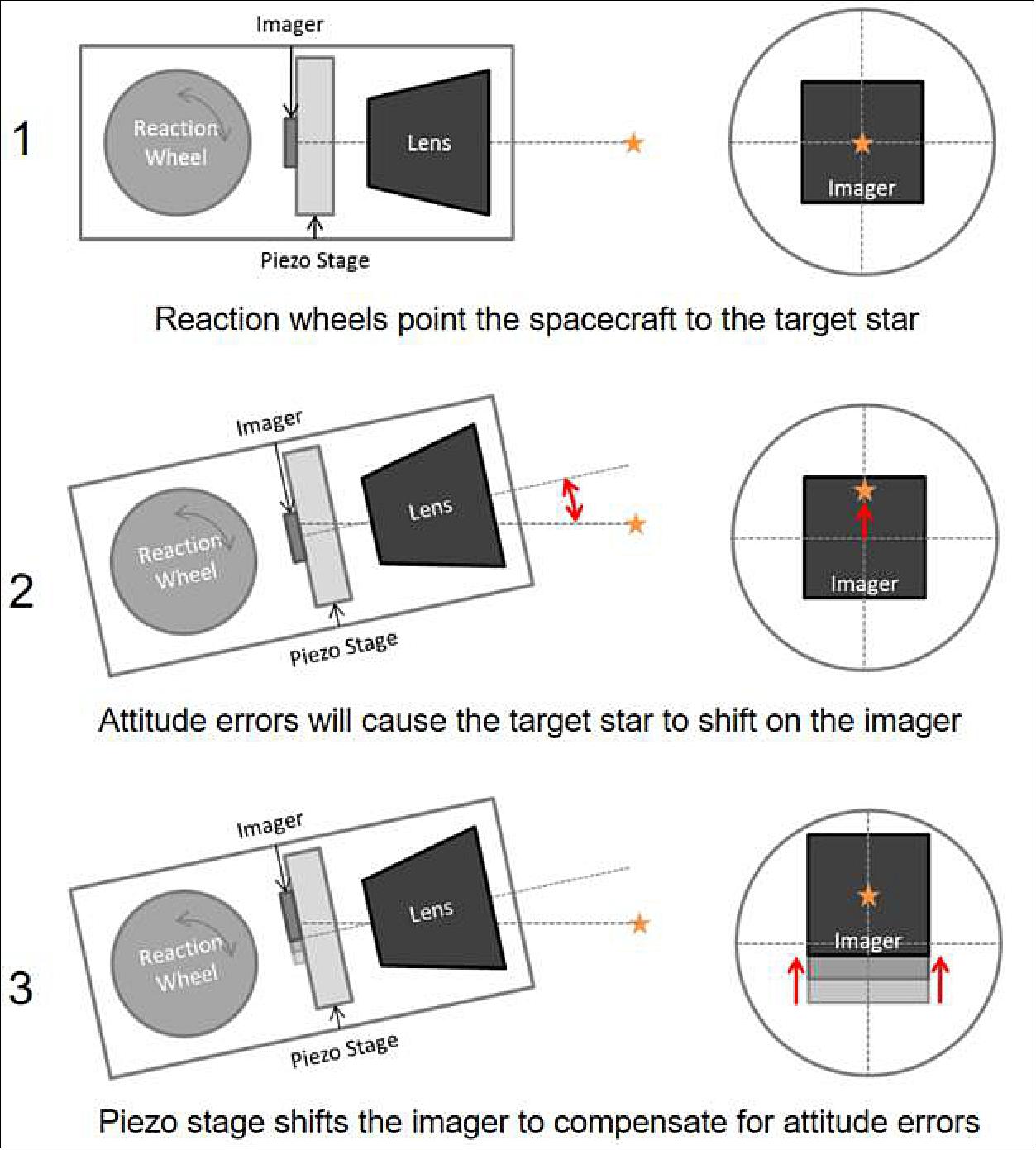
Thermal Control Approach: ASTERIA implements a multi-layered approach to thermal control. First, the OTA is isolated as much as possible from the payload electronics and the spacecraft bus. The only connection (besides electrical wiring) between the telescope and any part of the flight system is through titanium bipods that affix the OTA to the bottom panel of the spacecraft. The estimated total conductance of the bipods is 0.015 W/K.
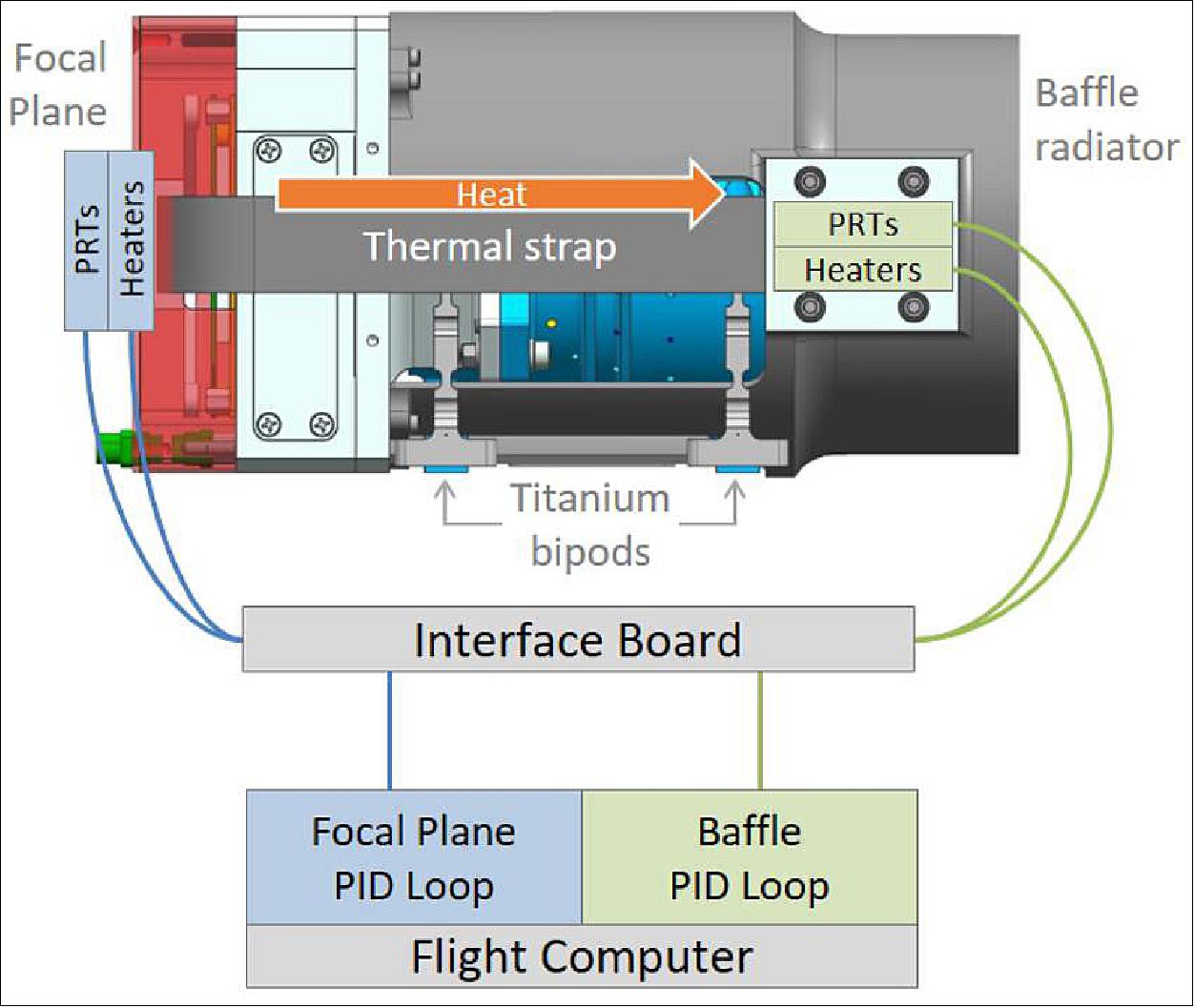
With the OTA isolated from the rest of the spacecraft, additional layers of thermal control are implemented as shown Figure 23. The imager—located inside the red enclosure—generates over 1 W of power while operating. This heat is moved from imager through a thermal strap (~1 W/K thermal conductance) to the baffle, which acts as a radiator to space. The OTA has two active thermal control loops, one at the imager and one at the baffle end of the thermal strap. Each control loop consists of several co-located platinum resistance thermometers (PRTs) and resistive heaters. A proportional-integral-derivative (PID) controller reads the PRTs and applies small amounts of heat to maintain the desired set points at the baffle and the focal plane. The control loop around the baffle acts as a “coarse” control, compensating for relatively large environmental disturbances and controlling to ±0.5 K. The control loop around the imager acts as “fine” control, compensating for residual fluctuations and controlling to ±0.01 K.
Interface Board: This temperature control scheme relies on measuring temperature differences with very high precision. The precision sensing/control electronics are located in a single printed circuit board measuring approximately 75 mm by 65 mm developed at JPL and referred to as the Interface Board. Figure 24 shows the Interface Board in context with the flight computer and thermal control hardware.
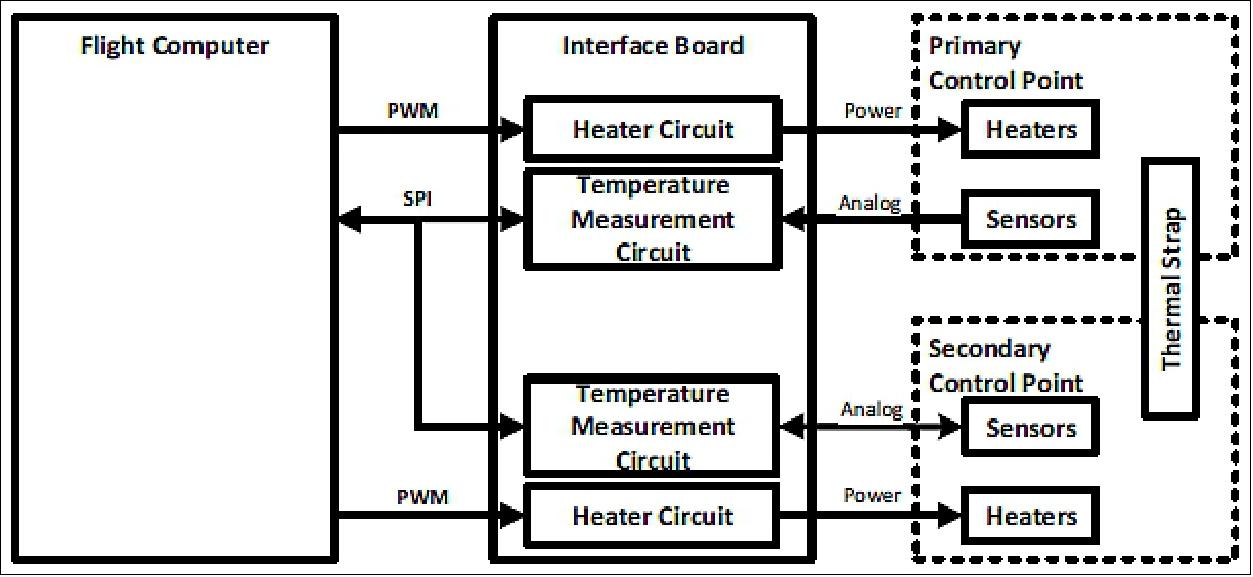
References
1) ”Arcsecond Space Telescope Enabling Research in Astrophysics (ASTERIA),”NASA/JPL, URL: http://www.jpl.nasa.gov/cubesat/missions/asteria.php
2) ”Exoplanet Space Missions,” http://seagerexoplanets.mit.edu/exoplanet.htm
3) ”Arcsecond Space Telescope Enabling Research in Astrophysics (ASTERIA),” NASA/JPL, URL: https://www.jpl.nasa.gov/cubesat/missions/asteria.php
4) ”ASTERIA;” NASA News, Oct. 18, 2017, URL: https://www.nasa.gov/mission_pages/station/research/experiments/2513.html
5) ”SpaceX CRS-12 Cargo Mission Launch,” NASA, August 14, 2017, URL: https://www.nasa.gov
/image-feature/spacex-crs-12-cargo-mission-launch
6) ”CRS-12 Dragon Resupply Mission,” SpaceX, URL: http://www.spacex.com/sites/spacex/files/crs12presskit.pdf
7) ”Tiny Satellite for Studying Distant Planets Goes Quiet,” NASA/JPL News, 3 January 2020, URL: https://www.jpl.nasa.gov/news/news.php?feature=7568
8) ASTERIA Image of Los Angeles 1,” NASA/JPL, 16 May 2019, URL: https://www.jpl.nasa.gov/spaceimages/details.php?id=PIA23124
9) ”ASTERIA Wins Small Satellite Mission of the Year Award,” NASA/JPL, News, 14 August 2018, URL: https://www.jpl.nasa.gov/news/news.php?release=2018-190&rn=news.xml&rst=7213
10) Christopher M. Pong, ”On-Orbit Performance & Operation of the Attitude & Pointing Control Subsystems on ASTERIA,” Proceedings of the 32nd Annual AIAA/USU Conference on Small Satellites, Logan UT, USA, Aug. 4-9, 2018, paper: SSC18-PI-34, URL: https://digitalcommons.usu.edu
/cgi/viewcontent.cgi?article=4173&context=smallsat
11) Matthew W. Smith, Amanda Donner, Mary Knapp, Christopher M. Pong, Colin Smith, Jason Luu, Peter Di Pasquale, Robert L. Bocchino Jr., Brian Campuzano, Jessica Loveland, Cody Colley, Alessandra Babuscia, Mary White, Joel Krajewski, Sara Seager, ”On-Orbit Results and Lessons Learned from the ASTERIA Space Telescope Mission,” Proceedings of the 32nd Annual AIAA/USU Conference on Small Satellites, Logan UT, USA, Aug. 4-9, 2018, paper: SSC18-I-08, URL: https://digitalcommons.usu.edu/cgi/viewcontent.cgi?article=4067&context=smallsat
12) ”Astrophysics CubeSat Demonstrates Big Potential in a Small Package,” NASA/JPL, 12 April 2018, URL: https://www.jpl.nasa.gov/news/news.php?release=2018-072
13) ”JPL Deploys a CubeSat for Astronomy,” NASA/JPL, 7 Dec. 2017, URL: https://www.jpl.nasa.gov/news/news.php?release=2017-314
14) ”NanoRacks Completes 13th CubeSat Deployment Mission from Space Station, First “Doublewide” Satellites,” NanoRacks, 21 Nov. 2017, URL: http://nanoracks.com/13-cubesat-deployment-doublewide/
The information compiled and edited in this article was provided by Herbert J. Kramer from his documentation of: ”Observation of the Earth and Its Environment: Survey of Missions and Sensors” (Springer Verlag) as well as many other sources after the publication of the 4th edition in 2002. - Comments and corrections to this article are always welcome for further updates (eoportal@symbios.space).
Spacecraft Launch Mission Status Sensor Complement References Back to top